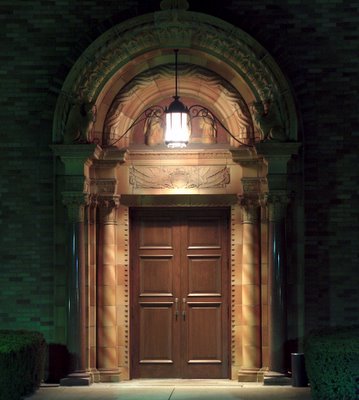
Tuesday, January 31, 2006
Sunday, January 29, 2006
Feedback on Quiz
I have received much feedback from my quiz What is your style of American Catholicism?
The various scores on this quiz are based on categories of American Catholics developed by Avery Cardinal Dulles and Deacon Owen F. Cummings. My original article on these categories is: The Seven Types of American Catholics.
Although the quiz was first posted here, it has spread all over the Internet.
Based on the feedback I've received:
Radical Catholic - 10% of total
Most priests and Religious find themselves placed in this category. They aren't Radical like the 1960s hippies, but instead are at the 'root' or radix of Christianity. These are true disciples of Christ, spending themselves in His service.
New Catholic - 29% of total
Most priests and religious get high scores in this category too. And most of the folks who write me say that they aren't young at all—they just have a youthful spirit. People in ths category have been strongly encouraged by the evangelization of Pope John Paul II. Reverts to the Faith tend to get this result. This is the second most popular quiz result.
Traditional Catholic - 36% of total
This is the most popular result of the test, which I find remarkable. People who get this answer often say "Of course I am traditional". They were not surprised by this test result. People who want the traditional Mass with chanting, and who take a negative view of the reforms since Vatican II find themselves in this category. I get many comments from people who WANT to attend a traditional Mass, but cannot due to geography. It would seem that there is not nearly a wide-enough availability of the traditional sacraments. But one person mentioned that he just likes the old style of art, and not the theology.
Evangelical Catholic- 12% of total
This is the third most-popular answer and most people are quite proud to be characterized like this. They typically expected to get this answer. Most Protestants who take this test get this category, as do many converts from Protestantism, and those who call themselves ecumenical.
Liberal Catholic - 6% of total
I get very strong reactions from those who score this category, often they reject this categorization or even the quiz itself. Of course, liberals by definition "do not want to be categorized by any artificially imposed categories", so a person who opposes categorization will almost by natural law get categorized like this. How's that for irony? A person who wants reform of basic Church doctrine will get into this category. They tend to be dismayed by my statement that they are too influenced by American culture, since many are strongly critical of the same, however, they have a very American-style of criticism, and so are ironically strongly influenced by American culture.
Neo-Conservative Catholic - 5% of total
Most people who get this answer are shocked and dismayed. They think that they are "good Catholics" but don't realize that they buy into rather uncharitable social theories. However, some tell me that they put forth a huge effort into raising a family, so the test needs to be modified to reflect this. This is a surprisingly rare test result, considering how many people in the Church could be characterized as conservative. I would suspect that the Church's social teaching is very well known these days. Others say that they know that they are strongly influenced by American culture, while others say that they left the Catholic Faith because of the Liberalism in the Church since the Second Vatican Council. I noticed a number of people scored quite high on both Neo-Conservative and Liberal, which seems contradictory.
Lukewarm Catholic - 2% of total
Typically atheists will get this result. My favorite quote from a quiz taker is "Cathlics SUCK". Often people will oppose what they misspell!
The various scores on this quiz are based on categories of American Catholics developed by Avery Cardinal Dulles and Deacon Owen F. Cummings. My original article on these categories is: The Seven Types of American Catholics.
Although the quiz was first posted here, it has spread all over the Internet.
Based on the feedback I've received:
Radical Catholic - 10% of total
Most priests and Religious find themselves placed in this category. They aren't Radical like the 1960s hippies, but instead are at the 'root' or radix of Christianity. These are true disciples of Christ, spending themselves in His service.
New Catholic - 29% of total
Most priests and religious get high scores in this category too. And most of the folks who write me say that they aren't young at all—they just have a youthful spirit. People in ths category have been strongly encouraged by the evangelization of Pope John Paul II. Reverts to the Faith tend to get this result. This is the second most popular quiz result.
Traditional Catholic - 36% of total
This is the most popular result of the test, which I find remarkable. People who get this answer often say "Of course I am traditional". They were not surprised by this test result. People who want the traditional Mass with chanting, and who take a negative view of the reforms since Vatican II find themselves in this category. I get many comments from people who WANT to attend a traditional Mass, but cannot due to geography. It would seem that there is not nearly a wide-enough availability of the traditional sacraments. But one person mentioned that he just likes the old style of art, and not the theology.
Evangelical Catholic- 12% of total
This is the third most-popular answer and most people are quite proud to be characterized like this. They typically expected to get this answer. Most Protestants who take this test get this category, as do many converts from Protestantism, and those who call themselves ecumenical.
Liberal Catholic - 6% of total
I get very strong reactions from those who score this category, often they reject this categorization or even the quiz itself. Of course, liberals by definition "do not want to be categorized by any artificially imposed categories", so a person who opposes categorization will almost by natural law get categorized like this. How's that for irony? A person who wants reform of basic Church doctrine will get into this category. They tend to be dismayed by my statement that they are too influenced by American culture, since many are strongly critical of the same, however, they have a very American-style of criticism, and so are ironically strongly influenced by American culture.
Neo-Conservative Catholic - 5% of total
Most people who get this answer are shocked and dismayed. They think that they are "good Catholics" but don't realize that they buy into rather uncharitable social theories. However, some tell me that they put forth a huge effort into raising a family, so the test needs to be modified to reflect this. This is a surprisingly rare test result, considering how many people in the Church could be characterized as conservative. I would suspect that the Church's social teaching is very well known these days. Others say that they know that they are strongly influenced by American culture, while others say that they left the Catholic Faith because of the Liberalism in the Church since the Second Vatican Council. I noticed a number of people scored quite high on both Neo-Conservative and Liberal, which seems contradictory.
Lukewarm Catholic - 2% of total
Typically atheists will get this result. My favorite quote from a quiz taker is "Cathlics SUCK". Often people will oppose what they misspell!
Thursday, January 26, 2006
Notes on Deus Caritas Est
Notes on Pope Benedict XVI's encyclical, Deus Caritas Est.
First Part
First Part
- There are many kinds of love, but the love between a man and a woman is the epitome. This kind of love, which is not planned or willed, but somehow imposed on us, is called eros by the ancient Greeks.
- Agape love is used in the New Testament for a new kind of love, one that is giving.
- The Enlightenment and Friedrich Nietzsche claimed that Christianity has poisoned eros, with all of its rules and regulations. But is this true?
- The ancient Greeks considered eros to be an intoxication, or divine madness. They thought that it allows man to experience supreme happiness. This led to fertility cults and temple prostitution.
- The Old Testament rejects this form of religion. Eros is dehumanized, and the temple prostitutes are degraded and exploited. Instead, eros needs purity and discipline.
- Love promises much, but must not be reduced to instincts. Instead it must be purified and mature.
- Man is a unity of both body and spirit. Both body and soul must be united in love.
- Nowadays, eros is reduced to just sex, a commodity. The exaltation of the body can readily lead to a hatred of it. Christian unity of body and soul lead to a need for "ascent, renunciation, purification and healing."
- The Old Testament book Song of Songs is a great mystical portrayal of love: it begins by self-seeking, intoxication, and happiness, and ends by seeking the good of the other, renunciation, and self-sacrifice. This is a great illustration of eros love leading to agape love.
- Higher love is exclusive and eternal.
- The Enlightenment set up a philosophical antithesis between ascending eros love and descending agape love, with the former being worldly, and the latter being Christian. This is not the Catholic tradition, which sees these two kinds of love as a unity. Man must give and receive love to be a whole person.
- Jacob's ladder is a symbol for this unified kind of love.
- Biblical faith is unique in the world in that God loves Man. God, in particular, seeks out Israel as his beloved, in a free and undeserved manner, not just for the benefit of Israel, but for the whole world. This is both eros love and agape love.
- God is portrayed as a lover seeking out his beloved, and Israel's idolatry is seen as adultery and prostitution.
- God's love is ultimately forgiving, even choosing His love over His justice.
- The mystics tell us that union with God is possible, and like lovers, although the two become one flesh, there isn't a fusion, but they remain individuals, and a single love is found between them.
- Eros is a part of human nature, and leads to marriage, where agape love can flourish. The bond between God and Israel is also a marriage, exclusive and eternal.
- Christ seeks his lost sheep and gives up his life on the Cross. Here God shows His love prevailing against His justice.
- The Eucharist is the enduring presence of the Cross and Resurrection, where Christ continues to give his whole self. This is an even greater image of the marriage between God and Israel.
- Eucharistic communion integrates both kinds of love, and makes all the Church and Christ one body as in a marriage bond.
- Faith, worship, and morality are inseparable, because of the unity of the Eucharist.
- The love for neighbor is now universal; but this is not limited to abstract feelings, but must be commitment in the here and now.
- Christ identifies himself with the poor, the stranger, the sick, and the imprisoned.
- We are to love God and each other. We cannot have one without the other.
- Love is not merely a sentiment, but is a unity of our intellect, will, and sentiments with the other. Lovers eventually become of one mind. Having love with God, then, is not just following a set of rules or commandments, but instead is doing God's Will because that is your will also. In this way, we can love our neighbor because we love with God's love, and see our neighbor through Christ's eyes..
- You don't practice charity if you do it by command, but only if it comes from love from within.
- Reflect on the role of the Deacons in the Book of Acts: these men "full of the Spirit and Wisdom" exercise the charity ministry in a well-ordered, communitarian way, providing a well-ordered love of neighbor.
- The three missions of the Church are Evangelization, the Liturgy, and Charity.
- Marxism says that we must not do charity, but instead pursue social justice. This is mistaken.
- Catholic social teaching is codified in the Compendium of the Social Doctrine of the Church, published in 2004 by the Pontifical Council Iustitia et Pax. The Church asserts that this doctrine has universal secular applicability.
- Social Justice is not the business of the Church, that is the business of politics. However, the Church must be free to inform politics on justice, using reason guided by faith.
- The State must have justice as its goal, otherwise it is just thievery: an exercise in special interests and power. Ethical blindness is always a danger.
- Politics is more than just making rules of public life. It must use reason and be moral.
- Catholic social teaching is based on reason and the natural law (human nature). The role of the Church in politics is to provide moral formation and purification of reason.
- The Church cannot take up the political battle for social justice; that is the role of the State, but instead must use rational argument and awaken the spiritual energy of people.
- Love is needed even in a just society. A bureaucracy is incapable of providing loving, personal concern. The claim that social justice makes charity unneeded is materialist and ignores the spiritual component of the human being.
- Charity must not be confused with Justice.
- The laity has the responsibility to be involved in politics.
- Modern communications makes it easy for us to see the suffering of others throughout the world, and to become aware of both spiritual and material poverty.
- Civil society exceeds individual means of providing charity.
- Cooperation between Church and State agencies can give a Christian flavor to these activities.
- Catholics need to cooperate with other Christian groups in doing charity.
- Christian charity must not just be social services.
- Charity workers must be professional, but also have a heartfelt concern for others. "Love of neighbor" must flow from their faith.
- Charity is to be independent of parties and ideologies. It is not to change the world. Instead, it is for spontaneously meeting personal needs of individuals.
- Evangelization and Charity are separate missions of the Church and should not be confused. Love is free and is not a means to another end. Even though the lack of God is a main reason for suffering, the faith must never be imposed on others. Silent love is the best example.
- Charity is to be practiced at all levels: the individual, parish, particular church, and universal church.
- All who work for Catholic charities must have a deep love of Christ; they must not be inspired by ideologies that promise to improve the world, and they also must be willing to cooperate with the Church and the Bishop.
- Remember what Saint Paul said: "If I give away all I have, and if I deliver my body to be burned, but do not have love, I gain nothing‚".
- Charity is the giving of the self.
- Those who serve others must be humble, and must not consider themselves superior to those they serve. Being able to serve others is not a merit, but a grace. We are only God's instruments; the burden of saving the world is not on us, we do what we can.
- We must not be driven by ideologies that claim to solve every problem; likewise, we should not give in to inertia where we think that we can't do anything.
- Those who do charity must have a deep prayer life. Prayer takes primacy over action, even in desperate situations.
- Activism and secularism has taken over much Christian charitable work. Instead, prayer conforms us to God's Will.
- In the face of overwhelming dispair, we must remember Job and Christ on the Cross.
- "Faith, Hope, and Charity go together". Love is the only light that can illuminate "a world grown dim"; it gives us courage to go on.
- We must recall the lives of the Saints: Martin of Tours, Anthony of the Desert, Francis of Assisi, Ignatius of Loyola, John of God, Camillus of Lellis, Vincent de Paul, Louise de Marillac, Giuseppe B. Cottolengo, John Bosco, Luigi Orione, Teresa of Calcutta, and emulate them.
- We must emulate the Blessed Virgin Mary, who lives in God's Will and is imbued with God's Word.
Second Part
Wednesday, January 25, 2006
Artist information needed
I am putting together a list of artists, architectects, composers, and workshops that produce excellent new Catholic liturgical art, in particular those who follow the great tradition. i am also interested in any exhibits or magazines that might help. If you know of some websites or other information, please email me at marcusscotus@sbcglobal.net
DEUS CARITAS EST
Today the Vatican published Pope Benedict XVI's first encyclical, Deus Caritas Est. It is a rich and relatively short document, and I suggest all to read it.
The encyclical begins with a theoretical discussion of love and ends with a teaching on social charity.
The major points are that:
The encyclical begins with a theoretical discussion of love and ends with a teaching on social charity.
The major points are that:
- Eros love, desire, should not be considered distinct from agape love, giving; they are both halves of a single kind of love that both takes and gives, desires and sacrifices. The opposition between the two was started in the Enlightenment, and has led to the many problems of our current day.
- Eucharistic communion integrates both kinds of love, and makes all the Church and Christ one body as in a marriage bond.
- We are to love God and each other. We cannot have one without the other.
- The three missions of the Church are Evangelization, the Sacraments, and Charity.
- Christ identifies himself with the poor, sick, and imprisoned, demanding that we are to charitable.
- Charity must not be confused with Justice; the Church must promote charity above justice.
- Justice is not the business of the Church, that is the business of society. However, the Church must inform society on justice, using reason guided by faith.
- The laity has the responsibility to be involved in society.
- Evangelization and Charity are separate missions and should not be confused.
- Those who do charity must have a deep prayer life.
Hippocratic Oath Changed - Again
See the article Cornell Medical School Turns Hippocratic Oath to (Mostly) Pabulum written by Wesley J. Smith The new version from Cornell drops the prohibition against sex between the doctor and patient. We are also told that this new version is 'inclusive'.
Oaths are usually used when power is given to someone and when we must trust them to do the right thing: doctors, lawyers, politicians, and soldiers all take oaths. Strictly speaking, a professional is someone who takes an oath—professes his trustworthiness.
We might as well compare the two versions here.
New: I do solemnly vow, to that which I value and hold most dear:
Old: I swear by Apollo Physician and Asclepius and Hygieia and Panaceia and all the gods and goddesses, making them my witnesses, that I will fulfill according to my ability and judgment this oath and this covenant:
I'm not a pagan so I do appreciate the dropping of those deities. But "vow" replaces "oath", and is a weaker term. Oaths invoke divine witness and include curses for those who fail to uphold their duties. The new version vows "to that which I value and hold most dear", which can mean anything at all, relative to the physician. He may hold beer most dear. The old version of the oath is that he "will fulfill according to my ability and judgment this oath and this covenant" so the physician swears that he will uphold what is included in the oath itself. "Covenant" is a strong word, meaning an indissoluble family bond.
New: That I will honor the Profession of Medicine, be just and generous to its members, and help sustain them in their service to humanity;
That just as I have learned from those who preceded me, so will I instruct those who follow me in the science and the art of medicine;
Old: To hold him who has taught me this art as equal to my parents and to live my life in partnership with him, and if he is in need of money to give him a share of mine, and to regard his offspring as equal to my brothers in male lineage and to teach them this art - if they desire to learn it - without fee and covenant; to give a share of precepts and oral instruction and all the other learning to my sons and to the sons of him who has instructed me and to pupils who have signed the covenant and have taken an oath according to the medical law, but no one else.
We have a welfare state nowadays, and nothing is done for free.
New: That I will recognize the limits of my knowledge and pursue lifelong learning to better care for the sick and to prevent illness;
That I will seek the counsel of others when they are more expert so as to fulfill my obligation to those who are entrusted to my care;
That I will not withdraw from my patients in their time of need;
That I will lead my life and practice my art with integrity and honor, using my power wisely;
Old: I will apply dietetic measures for the benefit of the sick according to my ability and judgment; I will keep them from harm and injustice.
I will neither give a deadly drug to anybody who asked for it, nor will I make a suggestion to this effect. Similarly will not give to a woman an abortive remedy. In purity and holiness I will guard my life and my art.
I will not use the knife, not even on sufferers from stone, but will withdraw in favor of such men as are engaged in this work.
The new version is clearer about expertise and the lack of it. The new version allows euthanasia and abortion. It substitutes " In purity and holiness I will guard my life and my art" with " I will lead my life and practice my art with integrity and honor, using my power wisely", which is weaker and secular, and drops the self-protection clause.
Completely new is "That I will not withdraw from my patients in their time of need"; this seems good at first. But some think that it can be construed to say that a physician cannot excuse himself morally, for example, if a patient requests abortion or euthanasia.
New: That whatsoever I shall see or hear of the lives of my patients that is not fitting to be spoken, I will keep in confidence;
That into whatever house I shall enter, it shall be for the good of the sick;
That I will maintain this sacred trust, holding myself far aloof from wrong, from corrupting, from the tempting of others to vice;
Old: Whatever houses I may visit, I will come for the benefit of the sick, remaining free of all intentional injustice, of all mischief and in particular of sexual relations with both female and male persons, be they free or slaves.
What I may see or hear in the course of the treatment or even outside of the treatment in regard to the life of men, which on no account one must spread abroad, I will keep to myself, holding such things shameful to be spoken about.
It used to be a physician was to remain "free of all intentional injustice, of all mischief" and now it is "far aloof from wrong". Most tellingly, the physician was to remain free "in particular of sexual relations" and this specific prohibition is now dropped. And just in case a person thinks that gay sex isn't really cheating, it adds "with both female and male persons". And we mustn't have a double standard based on rank: "be they free or slaves". The new version instead says that the physician must be free "from corrupting, from the tempting of others to vice".
"That into whatever house I shall enter". Do doctors still make house calls? Is it OK to do misdeeds in the clinic?
The new confidentiality clause seems weaker, too. So it is OK to disclose "fitting" information?
New: That above all else I will serve the highest interests of my patients through the practice of my science and my art;
That I will be an advocate for patients in need and strive for justice in the care of the sick.
I now turn to my calling, promising to preserve its finest traditions, with the reward of a long experience in the joy of healing.
I make this vow freely and upon my honor.
Old: If I fulfill this oath and do not violate it, may it be granted to me to enjoy life and art, being honored with fame among all men for all time to come; if I transgress it and swear falsely, may the opposite of all this be my lot.
The new version adds quite a bit including the promise to "strive for justice in the care of the sick", which I guess means that the physician vows to support socialized medicine.
The new version deletes the old curse clause " if I transgress it and swear falsely, may the opposite of all this be my lot."
The old version asks to be blessed with enjoyment of his art and his life and eternal universal fame. The new version only asks for " long experience in the joy of healing". The ancients were asking for sainthood, moderns are atheist.
Why was the ancient oath promulgated in the first place? Were there abuses that led to the need of an oath? Imagine these scenarios:
The patriarch of the family is elderly. Heirs want him dead so that they can inherit property. They pay the physician to kill him.
A doctor sells expensive quack remedies. He knows they are worthless.
A physician discloses that a patient has a deadly disease; the patient loses his job.
A physician discloses that someone has a sexually transmitted disease, ruining the patient's reputation.
A physician takes credit for the cure that his teacher developed.
The physician abuses his authority with his patients, convincing them to have sex with him. If he gets a female patient pregnant, he will abort the child.
Physicians release deadly pathogens into the environment to test effectiveness of vaccinations.
A physician practices dangerous treatments on his patients, or performs unnecessary surgeries.
Physicians conduct deadly medical experiments on prisoners.
A patient requests a treatment that is not helpful or even harmful. The physician complies.
In Plato's Republic, written sometime after the Hippocratic Oath, Socrates argues that the practice of politics should be like the practice of medicine: physicians were not out to defeat or dominate their patients, but had the best interests of the patient in mind. Nowadays physicians act like politicians, using their power to dominate patients and to extract their wealth.
It comes down to this. I place my life itself into the hands of a physician. Can I trust him?
Oaths are usually used when power is given to someone and when we must trust them to do the right thing: doctors, lawyers, politicians, and soldiers all take oaths. Strictly speaking, a professional is someone who takes an oath—professes his trustworthiness.
We might as well compare the two versions here.
New: I do solemnly vow, to that which I value and hold most dear:
Old: I swear by Apollo Physician and Asclepius and Hygieia and Panaceia and all the gods and goddesses, making them my witnesses, that I will fulfill according to my ability and judgment this oath and this covenant:
I'm not a pagan so I do appreciate the dropping of those deities. But "vow" replaces "oath", and is a weaker term. Oaths invoke divine witness and include curses for those who fail to uphold their duties. The new version vows "to that which I value and hold most dear", which can mean anything at all, relative to the physician. He may hold beer most dear. The old version of the oath is that he "will fulfill according to my ability and judgment this oath and this covenant" so the physician swears that he will uphold what is included in the oath itself. "Covenant" is a strong word, meaning an indissoluble family bond.
New: That I will honor the Profession of Medicine, be just and generous to its members, and help sustain them in their service to humanity;
That just as I have learned from those who preceded me, so will I instruct those who follow me in the science and the art of medicine;
Old: To hold him who has taught me this art as equal to my parents and to live my life in partnership with him, and if he is in need of money to give him a share of mine, and to regard his offspring as equal to my brothers in male lineage and to teach them this art - if they desire to learn it - without fee and covenant; to give a share of precepts and oral instruction and all the other learning to my sons and to the sons of him who has instructed me and to pupils who have signed the covenant and have taken an oath according to the medical law, but no one else.
We have a welfare state nowadays, and nothing is done for free.
New: That I will recognize the limits of my knowledge and pursue lifelong learning to better care for the sick and to prevent illness;
That I will seek the counsel of others when they are more expert so as to fulfill my obligation to those who are entrusted to my care;
That I will not withdraw from my patients in their time of need;
That I will lead my life and practice my art with integrity and honor, using my power wisely;
Old: I will apply dietetic measures for the benefit of the sick according to my ability and judgment; I will keep them from harm and injustice.
I will neither give a deadly drug to anybody who asked for it, nor will I make a suggestion to this effect. Similarly will not give to a woman an abortive remedy. In purity and holiness I will guard my life and my art.
I will not use the knife, not even on sufferers from stone, but will withdraw in favor of such men as are engaged in this work.
The new version is clearer about expertise and the lack of it. The new version allows euthanasia and abortion. It substitutes " In purity and holiness I will guard my life and my art" with " I will lead my life and practice my art with integrity and honor, using my power wisely", which is weaker and secular, and drops the self-protection clause.
Completely new is "That I will not withdraw from my patients in their time of need"; this seems good at first. But some think that it can be construed to say that a physician cannot excuse himself morally, for example, if a patient requests abortion or euthanasia.
New: That whatsoever I shall see or hear of the lives of my patients that is not fitting to be spoken, I will keep in confidence;
That into whatever house I shall enter, it shall be for the good of the sick;
That I will maintain this sacred trust, holding myself far aloof from wrong, from corrupting, from the tempting of others to vice;
Old: Whatever houses I may visit, I will come for the benefit of the sick, remaining free of all intentional injustice, of all mischief and in particular of sexual relations with both female and male persons, be they free or slaves.
What I may see or hear in the course of the treatment or even outside of the treatment in regard to the life of men, which on no account one must spread abroad, I will keep to myself, holding such things shameful to be spoken about.
It used to be a physician was to remain "free of all intentional injustice, of all mischief" and now it is "far aloof from wrong". Most tellingly, the physician was to remain free "in particular of sexual relations" and this specific prohibition is now dropped. And just in case a person thinks that gay sex isn't really cheating, it adds "with both female and male persons". And we mustn't have a double standard based on rank: "be they free or slaves". The new version instead says that the physician must be free "from corrupting, from the tempting of others to vice".
"That into whatever house I shall enter". Do doctors still make house calls? Is it OK to do misdeeds in the clinic?
The new confidentiality clause seems weaker, too. So it is OK to disclose "fitting" information?
New: That above all else I will serve the highest interests of my patients through the practice of my science and my art;
That I will be an advocate for patients in need and strive for justice in the care of the sick.
I now turn to my calling, promising to preserve its finest traditions, with the reward of a long experience in the joy of healing.
I make this vow freely and upon my honor.
Old: If I fulfill this oath and do not violate it, may it be granted to me to enjoy life and art, being honored with fame among all men for all time to come; if I transgress it and swear falsely, may the opposite of all this be my lot.
The new version adds quite a bit including the promise to "strive for justice in the care of the sick", which I guess means that the physician vows to support socialized medicine.
The new version deletes the old curse clause " if I transgress it and swear falsely, may the opposite of all this be my lot."
The old version asks to be blessed with enjoyment of his art and his life and eternal universal fame. The new version only asks for " long experience in the joy of healing". The ancients were asking for sainthood, moderns are atheist.
Why was the ancient oath promulgated in the first place? Were there abuses that led to the need of an oath? Imagine these scenarios:
The patriarch of the family is elderly. Heirs want him dead so that they can inherit property. They pay the physician to kill him.
A doctor sells expensive quack remedies. He knows they are worthless.
A physician discloses that a patient has a deadly disease; the patient loses his job.
A physician discloses that someone has a sexually transmitted disease, ruining the patient's reputation.
A physician takes credit for the cure that his teacher developed.
The physician abuses his authority with his patients, convincing them to have sex with him. If he gets a female patient pregnant, he will abort the child.
Physicians release deadly pathogens into the environment to test effectiveness of vaccinations.
A physician practices dangerous treatments on his patients, or performs unnecessary surgeries.
Physicians conduct deadly medical experiments on prisoners.
A patient requests a treatment that is not helpful or even harmful. The physician complies.
In Plato's Republic, written sometime after the Hippocratic Oath, Socrates argues that the practice of politics should be like the practice of medicine: physicians were not out to defeat or dominate their patients, but had the best interests of the patient in mind. Nowadays physicians act like politicians, using their power to dominate patients and to extract their wealth.
It comes down to this. I place my life itself into the hands of a physician. Can I trust him?
Tuesday, January 24, 2006
Photos of Annunziata Church in Ladue, Missouri
Here are photos of Annunziata Church in Ladue, Missouri, which is about eleven highway miles west of downtown Saint Louis.
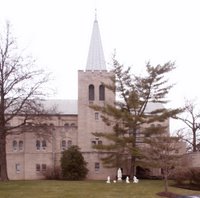
A view of the church, looking from the west.
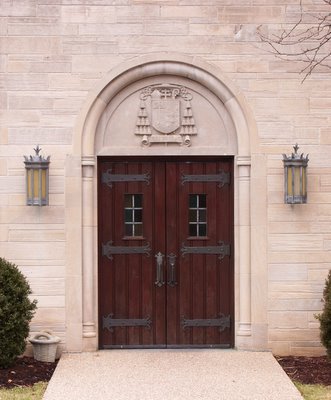
One of several exterior doors.
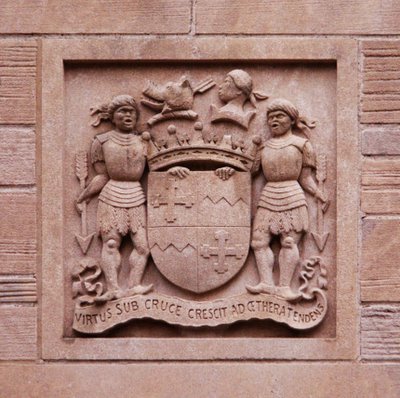
This stone carving is over the east door. The translation of the Latin is reportedly "virtue increases under a cross until it reaches the heavens".
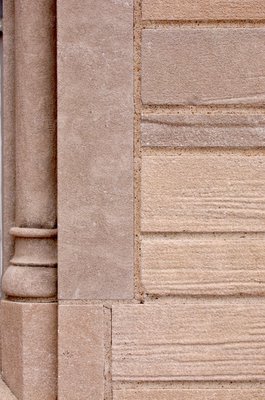
Exterior detail of some stonework. Nonmodern architecture includes detail on a human scale; the base of the attached column is only a few inches tall. The cut stone even has some detail of art in the finish of the face. The stone itself has natural detail that harmonizes with the human-made detail.
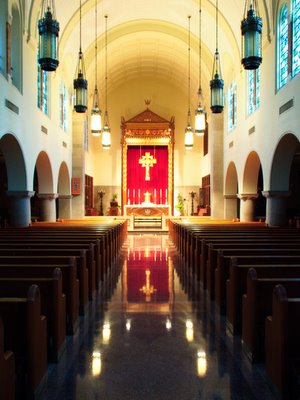
Inside the nave, looking towards the main altar. The church has the form of a Latin cross; side altars are in the transepts, and all the pews face foreward. There are aisles running down the sides behind the columns.
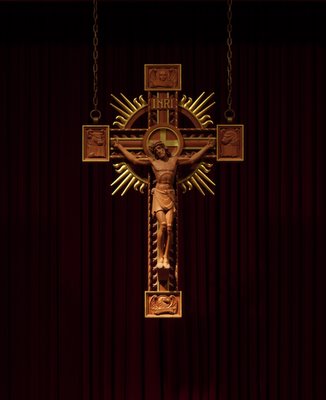
The crucifix. Large crucifixes such as this became common in the West during the High Middle Ages and is a familiar symbol of and object of devotion of Latin Christianity. On the ends of the cross are symbols of the Evangelists.
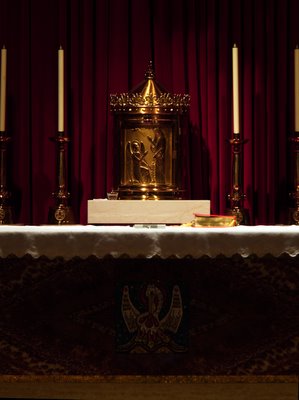
The tabernacle containing the Blessed Sacrament, with a depiction of the Annunciation. It is centered behind the detached main altar.
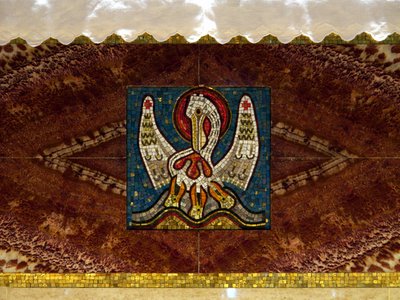
Detail of the altar, with a mosaic of the Christian symbol of the pelican. Sir Thomas Malory shows this symbol in his book Le Mort d'Arthur, his Christian romance story of King Arthur: "And so a little from thence he looked up into a tree, and there he saw a passing great bird upon an old tree, and it was passing dry, without leaves; and the bird sat above, and had birds, the which were dead for hunger. So smote he himself with his beak, the which was great and sharp. And so the great bird bled till that he died among his birds. And the young birds took the life by the blood of the great bird. When Bors saw this he wist well it was a great tokening..."
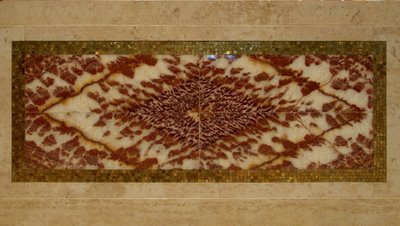
A detail of the communion rail. Note how the natural pattern in the stone is transformed by art into a symmetric design. Nonmodern design often uses natural patterns not merely in themselves, but in harmony with manmade-elements.
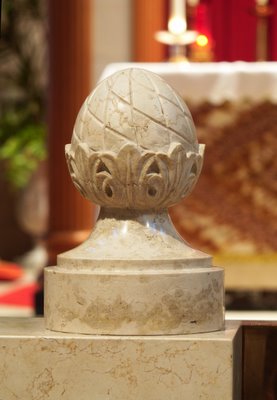
A pinecone finial on the end of the communion rail. The Christian symbol of the pinecone represents rebirth and forms the crown of the Tree of Life.
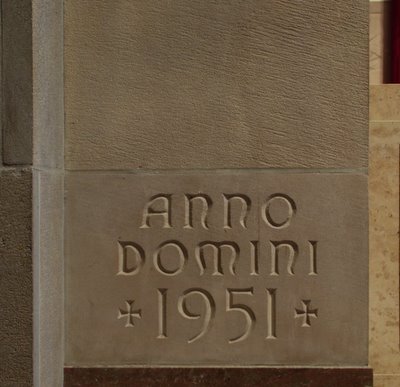
The Year of Our Lord 1951. This stone is set to the left of the communion rail. Within a few years, Modernism became universal in church design; but this church itself has elements of that trend, which began decades before, with a reduction of detail and symbolism.
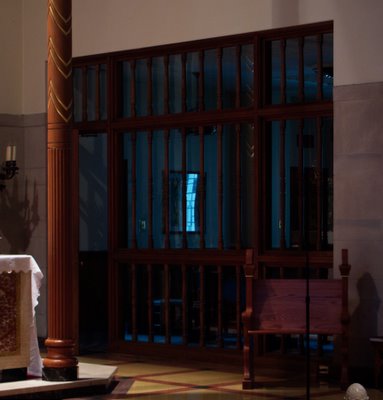
To the right of the altar is the glass-enclosed "cry room". It has become a tragedy in recent decades for many mainstream denominations: there is a deadly silence during their services because they lack children, and therefore, lack a future. In Europe, even Catholic churches have this silence of death.
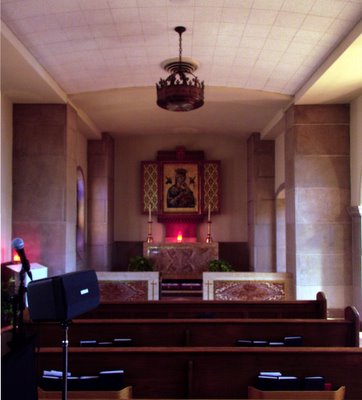
To the left of the main altar, in the west transept, is the altar of the Blessed Virgin Mary. This altar was in near total darkness, lit only by a red candle, and with what little light came through the dark stained glass windows on a dreary, overcast day.
"Why must holy places be dark places?" demanded the pagan Queen Orual in C.S. Lewis's novel Till We Have Faces. Orual, who hated the gods for taking away her beloved sister Psyche and for her own lack of physical beauty, veiled her ugly face from all. But it was her soul that was truly ugly. As she found out, we cannot see God face-to-face until we have a face; ours is veiled in the darkness of sin.
Shouldn't our Christian churches be bright, open, and airy? Shouldn't Redeemed Man be illuminated by the sun? Isn't this darkness a relic of our pagan, superstitious past?
But it was the Enlightenment—the belief that Man should conquer nature and determine his own destiny—that demanded that the Light of Reason flow into his meeting-houses. Man then is arrogant, and elevates himself to be a pagan god. But Man remains sinful, and the horrors of the 'Enlightened' 20th century should remind us that we remain in spiritual darkness.
This church of the Annunciation commemorates the Holy Spirit overshadowing the Blessed Virgin Mary. What is dark for us is not dark for the Lord; from Psalm 139:
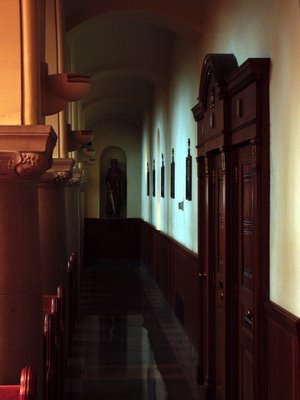
The aisle running down the western side of the name. In the background is a statue of Saint Louis, principal patron of the Archdiocese. To the right is a confessional.
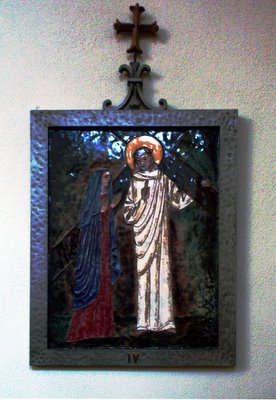
One of the Stations of the Cross, which are located in the side-aisles. It appears to be made of enameled metal.
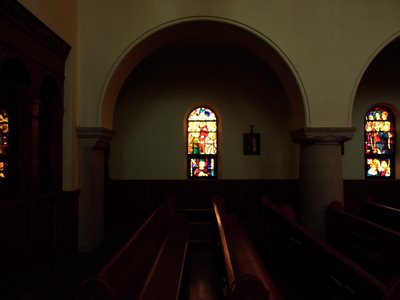
A view of the arches between the side-aisle and nave.
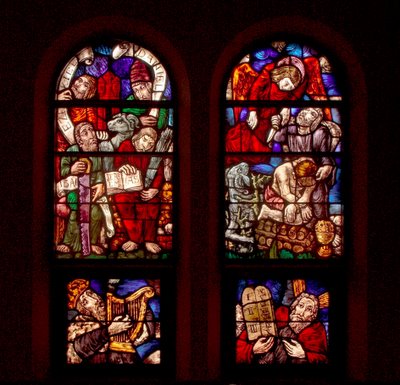
One of the stained glass windows. It depicts the Old Testament prophets, King David with his lyre, the Sacrifice of Abraham, and Moses with the Ten Commandments.
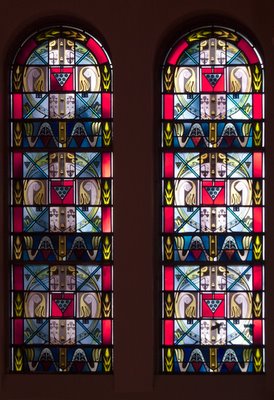
One of the clerestory windows, located high up on the nave walls. These typically are more abstract than the windows at eye-level, and are lighter in color, to allow a certain amount of filtered, indirect light into the main body of the church.
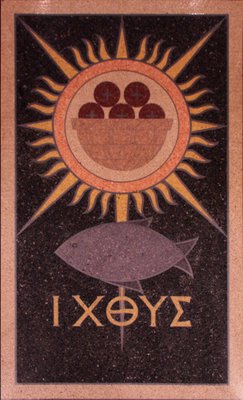
This mosaic is in the floor in front of the main altar. We have a basket of loaves and a fish, depicting one of the miracles of the Lord, and it is a sign of the Eucharist. The fish is one of the earliest Christian symbols, and is a common image in the Gospels. The Greek word for fish, ichthus, is also taken to be an acronym for Iesous Christos Theou Uiou Soter, or "Jesus Christ, God's Son, Savior."
Note that the rays coming from the basket of loaves is similar to those coming from Christ on the crucifix; and in turn both are similar to the rays used on a monstrance. It is not a coincidence.
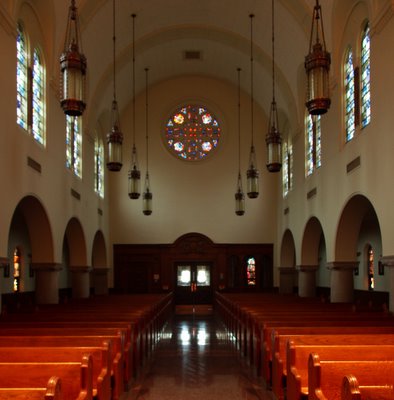
A view to the back of the church.
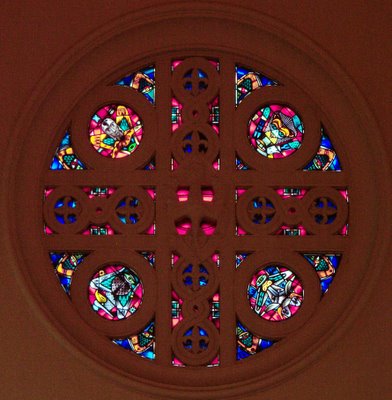
The rose window in the back of the church. Symbols of the Evangelists are in this window.
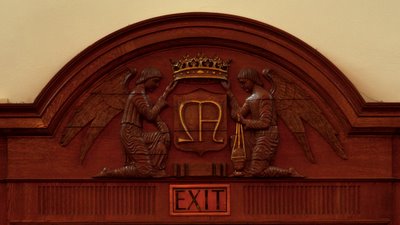
Wood carving over the front door to the church; two angels holding the crown of Christ the King, who is the Alpha and Omega, First and Last.
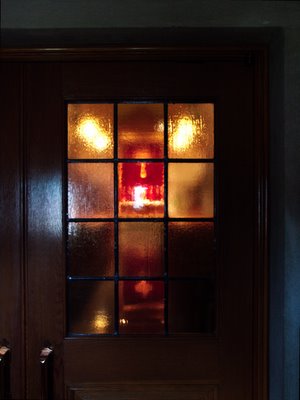
Here we take one last look back into the church from the narthex.

A look out the front door windows to Clayton Road below.
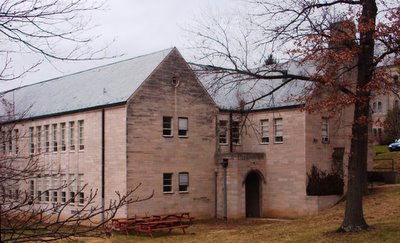
Here is the church's school.

A view of the church, looking from the west.

One of several exterior doors.

This stone carving is over the east door. The translation of the Latin is reportedly "virtue increases under a cross until it reaches the heavens".

Exterior detail of some stonework. Nonmodern architecture includes detail on a human scale; the base of the attached column is only a few inches tall. The cut stone even has some detail of art in the finish of the face. The stone itself has natural detail that harmonizes with the human-made detail.

Inside the nave, looking towards the main altar. The church has the form of a Latin cross; side altars are in the transepts, and all the pews face foreward. There are aisles running down the sides behind the columns.

The crucifix. Large crucifixes such as this became common in the West during the High Middle Ages and is a familiar symbol of and object of devotion of Latin Christianity. On the ends of the cross are symbols of the Evangelists.

The tabernacle containing the Blessed Sacrament, with a depiction of the Annunciation. It is centered behind the detached main altar.

Detail of the altar, with a mosaic of the Christian symbol of the pelican. Sir Thomas Malory shows this symbol in his book Le Mort d'Arthur, his Christian romance story of King Arthur: "And so a little from thence he looked up into a tree, and there he saw a passing great bird upon an old tree, and it was passing dry, without leaves; and the bird sat above, and had birds, the which were dead for hunger. So smote he himself with his beak, the which was great and sharp. And so the great bird bled till that he died among his birds. And the young birds took the life by the blood of the great bird. When Bors saw this he wist well it was a great tokening..."

A detail of the communion rail. Note how the natural pattern in the stone is transformed by art into a symmetric design. Nonmodern design often uses natural patterns not merely in themselves, but in harmony with manmade-elements.

A pinecone finial on the end of the communion rail. The Christian symbol of the pinecone represents rebirth and forms the crown of the Tree of Life.

The Year of Our Lord 1951. This stone is set to the left of the communion rail. Within a few years, Modernism became universal in church design; but this church itself has elements of that trend, which began decades before, with a reduction of detail and symbolism.

To the right of the altar is the glass-enclosed "cry room". It has become a tragedy in recent decades for many mainstream denominations: there is a deadly silence during their services because they lack children, and therefore, lack a future. In Europe, even Catholic churches have this silence of death.

To the left of the main altar, in the west transept, is the altar of the Blessed Virgin Mary. This altar was in near total darkness, lit only by a red candle, and with what little light came through the dark stained glass windows on a dreary, overcast day.
"Why must holy places be dark places?" demanded the pagan Queen Orual in C.S. Lewis's novel Till We Have Faces. Orual, who hated the gods for taking away her beloved sister Psyche and for her own lack of physical beauty, veiled her ugly face from all. But it was her soul that was truly ugly. As she found out, we cannot see God face-to-face until we have a face; ours is veiled in the darkness of sin.
Shouldn't our Christian churches be bright, open, and airy? Shouldn't Redeemed Man be illuminated by the sun? Isn't this darkness a relic of our pagan, superstitious past?
But it was the Enlightenment—the belief that Man should conquer nature and determine his own destiny—that demanded that the Light of Reason flow into his meeting-houses. Man then is arrogant, and elevates himself to be a pagan god. But Man remains sinful, and the horrors of the 'Enlightened' 20th century should remind us that we remain in spiritual darkness.
This church of the Annunciation commemorates the Holy Spirit overshadowing the Blessed Virgin Mary. What is dark for us is not dark for the Lord; from Psalm 139:
If I say: "Let the darkness hide meGod is to be our light, not our own Reason. That is why the Blessed Sacrament is well-lit; and often hidden clear windows illuminate the sanctuary in an otherwise dark church.
and the light around me be night,"
even darkness is not dark for you
and the night is as clear as the day.

The aisle running down the western side of the name. In the background is a statue of Saint Louis, principal patron of the Archdiocese. To the right is a confessional.

One of the Stations of the Cross, which are located in the side-aisles. It appears to be made of enameled metal.

A view of the arches between the side-aisle and nave.

One of the stained glass windows. It depicts the Old Testament prophets, King David with his lyre, the Sacrifice of Abraham, and Moses with the Ten Commandments.

One of the clerestory windows, located high up on the nave walls. These typically are more abstract than the windows at eye-level, and are lighter in color, to allow a certain amount of filtered, indirect light into the main body of the church.

This mosaic is in the floor in front of the main altar. We have a basket of loaves and a fish, depicting one of the miracles of the Lord, and it is a sign of the Eucharist. The fish is one of the earliest Christian symbols, and is a common image in the Gospels. The Greek word for fish, ichthus, is also taken to be an acronym for Iesous Christos Theou Uiou Soter, or "Jesus Christ, God's Son, Savior."
Note that the rays coming from the basket of loaves is similar to those coming from Christ on the crucifix; and in turn both are similar to the rays used on a monstrance. It is not a coincidence.

A view to the back of the church.

The rose window in the back of the church. Symbols of the Evangelists are in this window.

Wood carving over the front door to the church; two angels holding the crown of Christ the King, who is the Alpha and Omega, First and Last.

Here we take one last look back into the church from the narthex.

A look out the front door windows to Clayton Road below.

Here is the church's school.
Monday, January 23, 2006
Photos of Saint Vincent de Paul Church, in Saint Louis, Missouri
Here are photos of Saint Vincent de Paul Church, in Saint Louis, Missouri. This church was built in 1844 by the Congregation of the Mission (Vincentians) and is still staffed by that order. It is one of the oldest Catholic churches in the City of Saint Louis.
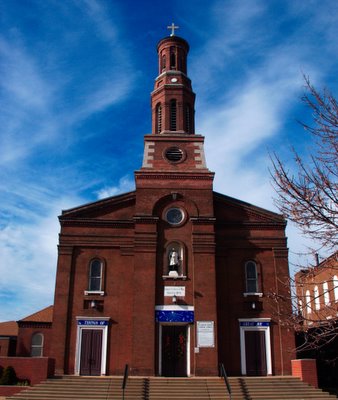
The church has a neoclassical facade; within a few decades, churches started being made again in the Gothic, or "Catholic Style".
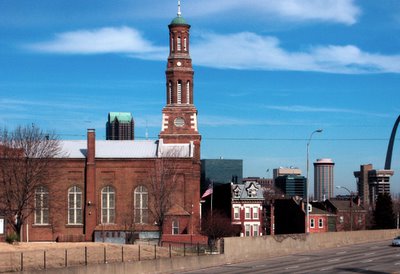
The church is located in the near south side of the city, on the edge of downtown. It is situated right on Interstate 55; the highway was built with a slight bend to the south to avoid the destruction of this church. Because of the highway blocking access, driving to this church may be somewhat difficult, unless you know which streets to take.
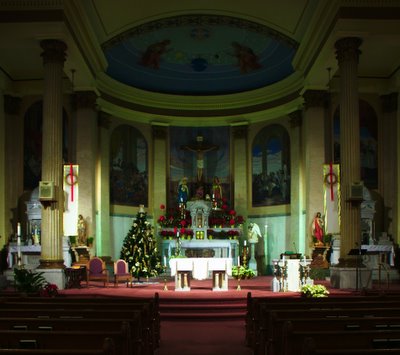
The main altar. The interior photos were taken on January 3rd, with the decorations of the Christmas Season.
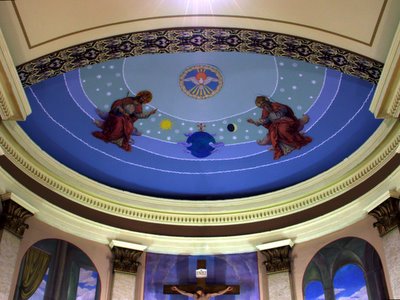
A painting above the altar, in the dome of the apse. The church also has numerous paintings of Vincentians and scenes from the history of the Congregation.
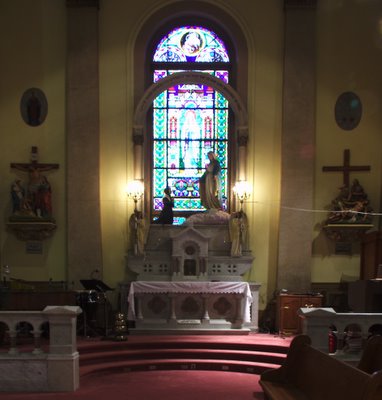
The church has four side-altars; this one is now used for the musicians.

Another side-altar.
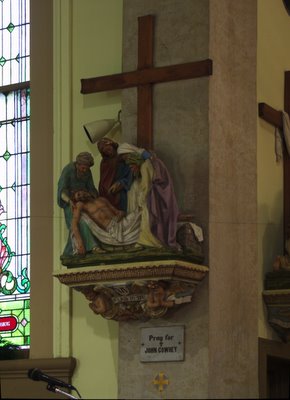
One of the Stations of the Cross.

These are some buildings next to the church, classic 19th-century row houses, common in the older parts of the city.
By walking around here on foot, I realized that this church is connected to other neighborhoods in ways of which I was unaware. There is a pedestrian bridge connecting this church property with Soulard Market (dating from 1770) and it abuts with the housing belonging to Saint Raymond's Maronite Cathedral.
Archdiocesan web page: http://www.archstl.org/index.php?option=com_adir&task=details&amokey=84&Itemid=80
Parish web page: http://www.stvstl.org

The church has a neoclassical facade; within a few decades, churches started being made again in the Gothic, or "Catholic Style".

The church is located in the near south side of the city, on the edge of downtown. It is situated right on Interstate 55; the highway was built with a slight bend to the south to avoid the destruction of this church. Because of the highway blocking access, driving to this church may be somewhat difficult, unless you know which streets to take.

The main altar. The interior photos were taken on January 3rd, with the decorations of the Christmas Season.

A painting above the altar, in the dome of the apse. The church also has numerous paintings of Vincentians and scenes from the history of the Congregation.

The church has four side-altars; this one is now used for the musicians.

Another side-altar.

One of the Stations of the Cross.

These are some buildings next to the church, classic 19th-century row houses, common in the older parts of the city.
By walking around here on foot, I realized that this church is connected to other neighborhoods in ways of which I was unaware. There is a pedestrian bridge connecting this church property with Soulard Market (dating from 1770) and it abuts with the housing belonging to Saint Raymond's Maronite Cathedral.
Archdiocesan web page: http://www.archstl.org/index.php?option=com_adir&task=details&amokey=84&Itemid=80
Parish web page: http://www.stvstl.org
Friday, January 20, 2006
Hopes Rise for Catholic-Orthodox Dialogue
From Zenit:
The Catholic addition of the filioque clause in the Nicene Creed (We believe in the Holy Spirit, the Lord, the giver of life, who proceeds from the Father and the Son.) is why the Orthodox call themselves orthodox, and Cardinal Ratzinger's famous omission of that clause from the Creed in the declaration Dominus Iesus is quite significant.
The Orthodox in principle have no problem with the concept of the Patriarch of Rome—the Pope—having primacy of honor among all the Patriarchs, but they would prefer to see him as first among equals, and not the final authority. However, the See of Peter even before Schism had greater authority than just honor. On the other hand, the Orthodox would like to see some better authority than what they have; for there is too much squabbling and frequent large-scale excommunication, and the sometimes heavy-handed authority of the Ecumenical Patriarch of Constantinople is often resented. In the West, the Pope has far greater power, but excommunications are very rare and there is much tolerance for questionable practices, as Catholics in the West are too far aware of. This system may suit the Orthodox: having a strong central power which does not use its disciplinary authority too often, and generally leaves most decisions at the local level. This will allow formal unity while respecting local autonomy.
A common problem among the Orthodox is overlapping Episcopal jurisdiction. The West has no problem with this, and even here in Saint Louis we have two Bishops in residence (one for the Latin Rite, the other for the Maronite), and the city is in the territories of various Bishops of other Rites. Among the Orthodox, the United States is ground zero for this controversy, with various local Bishops failing to recognize the ordinations of those whom they consider 'irregular'. Solving this problem would either have the Orthodox change their mind-set or it would require a massive Episcopal reorganization. However, there may be a solution where each Rite has its own bishop under the general episcopal authority of a territorial bishop, and there is precedent for this.
Theological differences abound, but even within the Catholic Church, differences of a certain sort between the Latin Rite and Eastern Catholics are accepted.
Finally, an Ecumenical Council could settle many matters, but all of those anathemas might be a bit scary, and lead to many schismatic groups.
We must not forget that Christian unity is a command from Our Lord, "that we all may be one".
Hopes Rise for Catholic-Orthodox DialogueWe shouldn't put too much hope in these ecumenical meetings, but certainly I find this kind of ecumenism to be far more important than those the Church has had in the past, since Catholics recognize the Orthodox as having valid orders and sacraments. But then again, Christians are all under severe political attack and Benjamin Franklin's famous phrase "join or die" is quite applicable here.
Commission to Meet in Belgrade in September
VATICAN CITY, JAN. 20, 2006 (Zenit.org).- This is the year to relaunch the dialogue between the Catholic and Orthodox Churches, says an article in L'Osservatore Romano.
The report of Monsignor Eleuterio Fortino, undersecretary of the Pontifical Council for Promoting Christian Unity, published in Thursday's Italian edition of the newspaper, explained that relations between these Churches have been unblocked in the last few months.
Next Sept. 18-25, the Serbian Orthodox Church will host the plenary session of a mixed commission made up of representatives of the Catholic Church and various Orthodox Churches, the works of which have been at a standstill since a meeting in 2000.
That meeting in Baltimore, Maryland, ended without an agreement because of discrepancies "over the theological concept of Uniatism," the principle by which the Eastern Churches that share the liturgy and traditions of the Orthodox Churches have joined the Church of Rome, recalled Monsignor Fortino.
Nonetheless, that meeting was useful, acknowledged the article.
"It concretized the authentic nature of the problem under discussion," stated Monsignor Fortino. "The birth of the Catholic Eastern Churches is profoundly linked to the affirmation of the primacy of the Bishop of Rome in the Church of Christ."
Therefore, the "primacy of the Church" will be one of the key topics for the future of the Catholic-Orthodox dialogue.
Patriarch's part
The Belgrade meeting will take place, as the article reports, thanks to the commitment of Ecumenical Patriarch Bartholomew I of Constantinople. Last September the patriarch brought together the designated representatives of the Orthodox Churches for the dialogue with the Catholic Church.
That meeting's final communiqué explained that "for the topics that affect the faith it is indispensable that unity be sought in the ambit prior to the schism" of 1054.
From Dec. 13-15, 2005, the mixed commission met in Rome to prepare the Belgrade meeting.
At the end of the meeting, the Catholic and Orthodox representatives were received by Benedict XVI, who said that in this new phase of dialogue two aspects will have to be considered.
"On the one hand," he said, "eliminating the remaining differences, and on the other, upholding the fundamental desire to do everything possible to re-establish full communion, which is so essential for the community of the disciples of Christ, as the preparatory document of your work makes clear."
Patriarch Bartholomew I has invited Benedict XVI to visit Turkey, a pastoral visit that might help spur Catholic-Orthodox dialogue in 2006.
The article published by L'Osservatore Romano is the first of a series to assess the ecumenical relations between the Catholic Church and the other Christian confessions, in the context of the Week of Prayer for Christian Unity.
The Catholic addition of the filioque clause in the Nicene Creed (We believe in the Holy Spirit, the Lord, the giver of life, who proceeds from the Father and the Son.) is why the Orthodox call themselves orthodox, and Cardinal Ratzinger's famous omission of that clause from the Creed in the declaration Dominus Iesus is quite significant.
The Orthodox in principle have no problem with the concept of the Patriarch of Rome—the Pope—having primacy of honor among all the Patriarchs, but they would prefer to see him as first among equals, and not the final authority. However, the See of Peter even before Schism had greater authority than just honor. On the other hand, the Orthodox would like to see some better authority than what they have; for there is too much squabbling and frequent large-scale excommunication, and the sometimes heavy-handed authority of the Ecumenical Patriarch of Constantinople is often resented. In the West, the Pope has far greater power, but excommunications are very rare and there is much tolerance for questionable practices, as Catholics in the West are too far aware of. This system may suit the Orthodox: having a strong central power which does not use its disciplinary authority too often, and generally leaves most decisions at the local level. This will allow formal unity while respecting local autonomy.
A common problem among the Orthodox is overlapping Episcopal jurisdiction. The West has no problem with this, and even here in Saint Louis we have two Bishops in residence (one for the Latin Rite, the other for the Maronite), and the city is in the territories of various Bishops of other Rites. Among the Orthodox, the United States is ground zero for this controversy, with various local Bishops failing to recognize the ordinations of those whom they consider 'irregular'. Solving this problem would either have the Orthodox change their mind-set or it would require a massive Episcopal reorganization. However, there may be a solution where each Rite has its own bishop under the general episcopal authority of a territorial bishop, and there is precedent for this.
Theological differences abound, but even within the Catholic Church, differences of a certain sort between the Latin Rite and Eastern Catholics are accepted.
Finally, an Ecumenical Council could settle many matters, but all of those anathemas might be a bit scary, and lead to many schismatic groups.
We must not forget that Christian unity is a command from Our Lord, "that we all may be one".
The Controversies at Mount Athos
Mount Athos—The Holy Mountain—is an autonomous theocratic monastic republic in Greece, and is the center of Orthodox Christian monasticism; the Ecumenical Patriarch in Constantinople is its spiritual head, and it is subject to the Greek ministry of foreign affairs. Each monastery is governed by a Superior, elected for life, and all of the Superiors make up the Holy Assembly which has legislative authority. Only males over the age of eighteen can visit the Holy Mountain, and typically only as pilgrims, with written permission. Unlike Western monasticism, Orthodoxy does not have separate Religious Orders, and tends to be organized under a general rule and under a territorial Bishop, so the organization of the monasteries is more political rather than a recognition of separate spiritual charisms.
Tradition holds that the Blessed Virgin Mary and Saint John the Evangelist stopped here during a voyage to Cyprus. Monasticism began here at least as early as the fifth century, and the oldest existing monastery dates from 963 A.D.
Mount Athos is actually a peninsula, surrounded by treacherous waters of the Aegean Sea. It is also rugged, with sheer cliffs and a maximum height of 6,670 feet. This is a good place to be solitary, away from the world. However, the world doesn't leave Mount Athos alone, and the monasteries are actually medieval walled fortresses, originally built to withstand attacks from pirates, and the many invading armies, including the Franks and Ottomans.
Mount Athos was granted independence by the Byzantine Empire in 1054. During the Fourth Crusade, the Empire collapsed, and Mount Athos was under the personal protection of Pope Innocent III. After the Council of Florence, it seems that Catholicism and Orthodoxy were to be reunited, but the final destruction of the Empire by the Ottomans crushed that dream of unity. The Muslim overlords placed Mount Athos under heavy taxation.
The Holy Mountain is now a part of a different empire, the European Union.
Through the Greek Constitution, the EU recognizes the right of Mount Athos to exist, but its status "is justified exclusively on grounds of a spiritual and religious nature" Here is the relevant article in the Constitution:
But the EU is not satisfied with what is in the Greek Constitution. From the Commission dealing with interstate commerce:
The EU has recently paid for extensive restoration of the monasteries, as well as conservation and cataloguing of the many ancient artworks and books owned by the monks. It does this under the guidelines of UNESCO, the United Nations Educational, Scientific and Cultural Organization, which has declared Mount Athos a World heritage Site. According to UNESCO:
UNESCO has a policy of "Authenticity", which is a term derived from Existentialist philosophy, and has linkages to Marxist, Nazi, Liberal Christian, and postmodern thought. The concept of Authenticity is rooted in subjective Cartesian philosophy of Mind/Body Dualism, and tends to deny the concept of objective reality which we all share, and instead emphasizes individual states of mind. Now it is very nice if we have a building which has been perfectly unchanged, but in reality, buildings and such are used every day by real people, according to their needs, and sometimes those needs change. "Authenticity" leads to a museum mentality, where we show off to a cultivated elite what some people in the past used to believe—and the unstated but implicit notion that no one actually believes that anymore. This leads to the troubling idea of forcing people into two categories: either you live an 'authentic' life in the proper context, or you move to the city and become a modern, completely abandoning your heritage and starting over, creating a new 'authenticity'. This means that the monks of Mount Athos can't control their properties as they see fit and change them according to their needs. UNESCO also discourages the rebuilding of destroyed buildings, since this is inauthentic; ancient styles are seen as historical relics and must not be recreated. Likewise, UNESCO discourages the building of new structures in ancient styles, again this is seen as inauthentic. This latter guideline is actually the law in places like Britain and in some U.S. Government agencies: you have to, by law, build in the Modern style. An alienated, content-free artform is authentic, you see.
The pursuit of 'authenticity' as a Greatest Good has led to the concept of the 'anti-hero', emulation of urban street-culture, and a rejection of classical art forms. It denies the principle of organic change, growth, and a living tradition.
Since the EU gives Mount Athos money for preservation, this makes it believe that it can have more say in how Mount Athos is governed.
Based on the Charter of Fundamental Rights of the European Union, Article 23, "Equality Between Men and Women", the European Parliament
Mount Athos is also known for its practice of Hesychasm, or "prayer of the heart", a spiritual practice rooted in neo-Platonism. The controversy over this practice greatly divided Orthodoxy in the 14th century, leading to many excommunications and meddling by the Imperial Government, which unfortunately tends to be norm within Orthodoxy. This controversy led to great weakening and divisions in the Christian East. However, this practice eventually was upheld, and is a major point of division between Orthodox and Catholics.
Hesychasm is the only mystical tradition within Orthodoxy, unlike the West, which has many. Western mysticism is seen in more a personal light, in a rightly-reasoned subjectivism and typically is not bound for belief by the faithful, while this form of Eastern mysticism seems to have more official status.
This practice seems to contradict the western Aristotelian view of reality. Even before the Latin Church accepted Aristotelian philosophy in the 13th century, it had some neo-Platonic foundation of theology, especially in the writings of Saint Augustine, but the Hesychasts seem to go too far in this, and are sometimes accused of Pantheism.
Since the Second Vatican Council era, the views of Aristotle, and consequently, Saint Thomas Aquinas and the Schoolmen has been denigrated by many Catholics. Many Latin Catholics have been attracted to Eastern-style Christianity, but often in a pick-and-choose cafeteria-style fashion that contradicts both the Western and Eastern Christian traditions, and often in a way that leads directly to heresy or outright apostasy from Christianity. Thomas Merton, who was otherwise orthodox, seemed to be heading in that wrong direction when he died; he was a great champion of Eastern prayer tradition. Even Eastern European Catholics who have integrated the two systems have done it in a slow, organic way and therefore have remained both Catholic and Eastern. But Thomistic philosophy is far more in keeping with Western tradition, and reading Saint Thomas readily "makes sense" to most Western minds. But it would be otherwise for most Easterners.
The Western Tradition tends to place much more emphasis on intellectual formation than the East, which is more liturgical. The Eastern tradition has roots that go back to the ancient Desert Fathers, who considered owning too many books as a temptation against the love of poverty. So while Westerners, attracted to this Eastern monasticism, may want to think that they can achieve salvation through just saying the Jesus Prayer over and over again like a mantra, err in failing to observe the complete Eastern religious life, which includes the extensive and highly elaborate prayers of the Hours (starting at 1 a.m.), community life, close spiritual direction, a strict moral code, extreme poverty, obedience to superiors, corporal mortifications, art traditions, and the Sacraments including the Divine Liturgy. The Western tradition is far more intellectual and—outside of Traditional Latin Mass communities—currently has a fairly weak liturgical, devotional, and artistic life. These weaknesses are perhaps what attracts some Eastward. And for others, eliminating all of the "Christ stuff" and just saying a mantra has great appeal to those who do not wish to compromise with doing their own will, which is well fitting with the modern religious "ABC" seekers who want Anything But Christianity.
Pope Benedict XVI seems to be far more sympathetic with the Eastern view, especially considering his Platonic philosophy—he is the first non-Aristotelian Pope in centuries. Clearly he wants to enrich the Liturgy of the West. Pope John Paul II is quite famous for saying that the Church should be "breathing with both lungs"—both East and West. But in my opinion, the loss of Thomism has led to much confusion in the West; and the Western liturgy has gone even farther way from the East in being over-simplified instead of being richly elaborated.
There are monks at Esfigmenou Monastery on Mount Athos who are refusing to include prayers for Ecumenical Patriarch Bartholomew I in their liturgies, because of his ecumenical talks with the Catholic Church, for which they consider him a heretic. They also do not recognize the Greek Orthodox Church and have refused funding from the EU for restoring their monastery. The Ecumenical Patriarch in turn declared them schismatics and the Greek Government has upheld an expulsion order for the monks. Deliveries of food, medicine, and heating oil has been halted and phone service disconnected.
In once sense, I don't blame the monks, for the Catholic Church is visibly full of heretics of almost the worst kind; I'm Catholic and I know! On the other hand, they don't have the authority to make ecumenical descisions—only the Ecumenical Patriarch has that authority, and he is their superior deserving of obedience.
Tradition holds that the Blessed Virgin Mary and Saint John the Evangelist stopped here during a voyage to Cyprus. Monasticism began here at least as early as the fifth century, and the oldest existing monastery dates from 963 A.D.
Mount Athos is actually a peninsula, surrounded by treacherous waters of the Aegean Sea. It is also rugged, with sheer cliffs and a maximum height of 6,670 feet. This is a good place to be solitary, away from the world. However, the world doesn't leave Mount Athos alone, and the monasteries are actually medieval walled fortresses, originally built to withstand attacks from pirates, and the many invading armies, including the Franks and Ottomans.
Mount Athos was granted independence by the Byzantine Empire in 1054. During the Fourth Crusade, the Empire collapsed, and Mount Athos was under the personal protection of Pope Innocent III. After the Council of Florence, it seems that Catholicism and Orthodoxy were to be reunited, but the final destruction of the Empire by the Ottomans crushed that dream of unity. The Muslim overlords placed Mount Athos under heavy taxation.
The Holy Mountain is now a part of a different empire, the European Union.
Through the Greek Constitution, the EU recognizes the right of Mount Athos to exist, but its status "is justified exclusively on grounds of a spiritual and religious nature" Here is the relevant article in the Constitution:
Article 105
1. The Athos peninsula extending beyond Megali Vigla and constituting the region of Aghion Oros [Holy Mountain] shall, in accordance with its ancient privileged status, be a self-governed part of the Greek State, whose sovereignty thereon shall remain intact. Spiritually, Aghion Oros shall come under the direct jurisdiction of the Ecumenical Patriarchate. All persons leading a monastic life thereon acquire Greek citizenship without further formalities, upon admission as novices or monks.
2. Aghion Oros shall be governed, according to its regime, by its twenty Holy Monasteries among which the entire Athos peninsula is divided; the territory of the peninsula shall be exempt from expropriation.
The administration of Aghion Oros shall be exercised by representatives of the Holy Monasteries constituting the Holy Community. No change whatsoever shall be permitted in the administrative system or in the number of Monasteries of Aghion Oros, or in their hierarchical order or in their position to their subordinate dependencies. Heterodox or schismatic persons shall be prohibited from dwelling thereon.
3. The determination in detail of the regimes of the Aghion Oros entities and the manner of operation thereof is effected by the Charter of Aghion Oros which, with the cooperation of the State representative, shall be drawn up and voted by the twenty Holy Monasteries and ratified by the Ecumenical Patriarchate and the Parliament of the Hellenes.
4. Faithful observance of the regimes of the Aghion Oros entities shall in the spiritual field be under the supreme supervision of the Ecumenical Patriarchate, and, in the administrative, under the supervision of the State, which shall also be exclusively responsible for safeguarding public order and security.
5. The afore-mentioned powers of the State shall be exercised through a governor whose rights and duties shall be determined by law.
The law shall likewise determine the judicial power exercised by the monastic authorities and the Holy Community, as well as the customs and taxation privileges of Aghion Oros.
But the EU is not satisfied with what is in the Greek Constitution. From the Commission dealing with interstate commerce:
The provisions of this Directive shall not prevent Greece from maintaining the specific status granted to Mount Athos as guaranteed by Article 105 of the Greek Constitution. If the Commission considers that the exclusions provided for in paragraphs 1, 2, 3 and 4 are no longer justified, particularly in terms of fair competition, it shall submit appropriate proposals to the Council.So the EU, for the reasons of commerce, may override the Greek Constitution of the paragraphs which make the Holy Mountain of Mount Athos actually holy. The EU would only maintain the paragraph which says that the power of the State shall be exercised through a governor. Likewise, in American Federal lawmaking, nearly every statute is justified because of the Interstate Commerce Clause of the Constitution, even in matters that have nothing to do with commerce.
The EU has recently paid for extensive restoration of the monasteries, as well as conservation and cataloguing of the many ancient artworks and books owned by the monks. It does this under the guidelines of UNESCO, the United Nations Educational, Scientific and Cultural Organization, which has declared Mount Athos a World heritage Site. According to UNESCO:
What makes the concept of World Heritage exceptional is its universal application. World Heritage sites belong to all the peoples of the world, irrespective of the territory on which they are located.So according to the EU, Mount Athos does not belong to the monks, or to the monasteries, or to the Orthodox Churches, or even to Christendom at large, but instead belongs to "all the peoples of the world", which should be troubling. UNESCO recently made the Mount Athos natural environment a concern, which adds further restrictions.
UNESCO has a policy of "Authenticity", which is a term derived from Existentialist philosophy, and has linkages to Marxist, Nazi, Liberal Christian, and postmodern thought. The concept of Authenticity is rooted in subjective Cartesian philosophy of Mind/Body Dualism, and tends to deny the concept of objective reality which we all share, and instead emphasizes individual states of mind. Now it is very nice if we have a building which has been perfectly unchanged, but in reality, buildings and such are used every day by real people, according to their needs, and sometimes those needs change. "Authenticity" leads to a museum mentality, where we show off to a cultivated elite what some people in the past used to believe—and the unstated but implicit notion that no one actually believes that anymore. This leads to the troubling idea of forcing people into two categories: either you live an 'authentic' life in the proper context, or you move to the city and become a modern, completely abandoning your heritage and starting over, creating a new 'authenticity'. This means that the monks of Mount Athos can't control their properties as they see fit and change them according to their needs. UNESCO also discourages the rebuilding of destroyed buildings, since this is inauthentic; ancient styles are seen as historical relics and must not be recreated. Likewise, UNESCO discourages the building of new structures in ancient styles, again this is seen as inauthentic. This latter guideline is actually the law in places like Britain and in some U.S. Government agencies: you have to, by law, build in the Modern style. An alienated, content-free artform is authentic, you see.
The pursuit of 'authenticity' as a Greatest Good has led to the concept of the 'anti-hero', emulation of urban street-culture, and a rejection of classical art forms. It denies the principle of organic change, growth, and a living tradition.
Since the EU gives Mount Athos money for preservation, this makes it believe that it can have more say in how Mount Athos is governed.
Based on the Charter of Fundamental Rights of the European Union, Article 23, "Equality Between Men and Women", the European Parliament
"requests the lifting of the ban on women entering Mount Athos in Greece, a geographical area of 400 km2 where women's access is prohibited in accordance with a decision taken in 1045 by monks living in the 20 monasteries in the area, a decision which nowadays violates the universally recognized principle of gender equality, Community non-discrimination and equality legislation and the provisions relating to free movement of persons within the EU".It would take just a few judges to make this the law of the European Union, and would be a great breach of religious freedom, and a law like this would destroy monastic life. They would allow not only women, but naturally also schismatics and heretics. But Christianity has outlived many empires, and it will outlive any more that are to come. Perhaps if they find too many barbarians at their gates, they can upgrade their fortified castles to more contemporary standards, and perhaps find a new patron; maybe the Pope again!
Mount Athos is also known for its practice of Hesychasm, or "prayer of the heart", a spiritual practice rooted in neo-Platonism. The controversy over this practice greatly divided Orthodoxy in the 14th century, leading to many excommunications and meddling by the Imperial Government, which unfortunately tends to be norm within Orthodoxy. This controversy led to great weakening and divisions in the Christian East. However, this practice eventually was upheld, and is a major point of division between Orthodox and Catholics.
Hesychasm is the only mystical tradition within Orthodoxy, unlike the West, which has many. Western mysticism is seen in more a personal light, in a rightly-reasoned subjectivism and typically is not bound for belief by the faithful, while this form of Eastern mysticism seems to have more official status.
This practice seems to contradict the western Aristotelian view of reality. Even before the Latin Church accepted Aristotelian philosophy in the 13th century, it had some neo-Platonic foundation of theology, especially in the writings of Saint Augustine, but the Hesychasts seem to go too far in this, and are sometimes accused of Pantheism.
Since the Second Vatican Council era, the views of Aristotle, and consequently, Saint Thomas Aquinas and the Schoolmen has been denigrated by many Catholics. Many Latin Catholics have been attracted to Eastern-style Christianity, but often in a pick-and-choose cafeteria-style fashion that contradicts both the Western and Eastern Christian traditions, and often in a way that leads directly to heresy or outright apostasy from Christianity. Thomas Merton, who was otherwise orthodox, seemed to be heading in that wrong direction when he died; he was a great champion of Eastern prayer tradition. Even Eastern European Catholics who have integrated the two systems have done it in a slow, organic way and therefore have remained both Catholic and Eastern. But Thomistic philosophy is far more in keeping with Western tradition, and reading Saint Thomas readily "makes sense" to most Western minds. But it would be otherwise for most Easterners.
The Western Tradition tends to place much more emphasis on intellectual formation than the East, which is more liturgical. The Eastern tradition has roots that go back to the ancient Desert Fathers, who considered owning too many books as a temptation against the love of poverty. So while Westerners, attracted to this Eastern monasticism, may want to think that they can achieve salvation through just saying the Jesus Prayer over and over again like a mantra, err in failing to observe the complete Eastern religious life, which includes the extensive and highly elaborate prayers of the Hours (starting at 1 a.m.), community life, close spiritual direction, a strict moral code, extreme poverty, obedience to superiors, corporal mortifications, art traditions, and the Sacraments including the Divine Liturgy. The Western tradition is far more intellectual and—outside of Traditional Latin Mass communities—currently has a fairly weak liturgical, devotional, and artistic life. These weaknesses are perhaps what attracts some Eastward. And for others, eliminating all of the "Christ stuff" and just saying a mantra has great appeal to those who do not wish to compromise with doing their own will, which is well fitting with the modern religious "ABC" seekers who want Anything But Christianity.
Pope Benedict XVI seems to be far more sympathetic with the Eastern view, especially considering his Platonic philosophy—he is the first non-Aristotelian Pope in centuries. Clearly he wants to enrich the Liturgy of the West. Pope John Paul II is quite famous for saying that the Church should be "breathing with both lungs"—both East and West. But in my opinion, the loss of Thomism has led to much confusion in the West; and the Western liturgy has gone even farther way from the East in being over-simplified instead of being richly elaborated.
There are monks at Esfigmenou Monastery on Mount Athos who are refusing to include prayers for Ecumenical Patriarch Bartholomew I in their liturgies, because of his ecumenical talks with the Catholic Church, for which they consider him a heretic. They also do not recognize the Greek Orthodox Church and have refused funding from the EU for restoring their monastery. The Ecumenical Patriarch in turn declared them schismatics and the Greek Government has upheld an expulsion order for the monks. Deliveries of food, medicine, and heating oil has been halted and phone service disconnected.
In once sense, I don't blame the monks, for the Catholic Church is visibly full of heretics of almost the worst kind; I'm Catholic and I know! On the other hand, they don't have the authority to make ecumenical descisions—only the Ecumenical Patriarch has that authority, and he is their superior deserving of obedience.
Thursday, January 19, 2006
Utilitarianism on the March
See this article by the Anchoress about churches being especially at risk for being taken by eminent domain.
The Supreme Court Kelo decision gave broad powers of eminent domain for private purposes; most typically, wiping out neighborhoods for "big-box" retail developments.
We've had that kind of law in Missouri for years, and now it is nationwide. In Saint Louis, the Galleria mall and Meacham Park developments are prominent examples of private developers using eminent domain to force out property owners. Classically, eminent domain was primarily used by governments for building roads.
The justification for this is the principle of the greatest good for the greatest number of people, or utilitarianism. And the greatest good for a local municipality is tax revenue. A large retail development will cause greater economic activity than residential housing, therefore is justified. Under this view, churches, which are tax-exempt, have no economic value whatsoever, and will be at great risk for being taken under economic eminent domain.
Utilitarianism is nonpartisan; in the Kelo decision, it was presumably right-wing corporate interests who won (and also big government). But the entire range of issues associated with the Culture of Death—abortion, euthanasia, radical animal rights, sex-ed, bestiality, group marriage, etc.—left-wing issues all, are all justified by using the same utilitarianism.
The entire utilitarian moral system is logically flawed and can lead to dangerous conclusions, like for example, genocide. The alternative moral system, virtue ethics, is what is used by the Church and is the traditional morality understood worldwide and throughout history. Virtue ethics is based on two main principles: objective morality and human nature. Utilitarianism is subjective and is based on abstract utility-preferences and not human nature.
But because utilitarianism is based on constructing a single 'utility function' (typically money) and not on a large number of moral values, it is easy to do. You can subjectively create any utility function that you like, claim that it applies to the greatest number of people, and then call the outcome 'ethical'. The system is based on subjective preferences and not on objective facts, which should raise warning flags for Christians, since we know that people often have preferences for doing wrong.
The Supreme Court Kelo decision gave broad powers of eminent domain for private purposes; most typically, wiping out neighborhoods for "big-box" retail developments.
We've had that kind of law in Missouri for years, and now it is nationwide. In Saint Louis, the Galleria mall and Meacham Park developments are prominent examples of private developers using eminent domain to force out property owners. Classically, eminent domain was primarily used by governments for building roads.
The justification for this is the principle of the greatest good for the greatest number of people, or utilitarianism. And the greatest good for a local municipality is tax revenue. A large retail development will cause greater economic activity than residential housing, therefore is justified. Under this view, churches, which are tax-exempt, have no economic value whatsoever, and will be at great risk for being taken under economic eminent domain.
Utilitarianism is nonpartisan; in the Kelo decision, it was presumably right-wing corporate interests who won (and also big government). But the entire range of issues associated with the Culture of Death—abortion, euthanasia, radical animal rights, sex-ed, bestiality, group marriage, etc.—left-wing issues all, are all justified by using the same utilitarianism.
The entire utilitarian moral system is logically flawed and can lead to dangerous conclusions, like for example, genocide. The alternative moral system, virtue ethics, is what is used by the Church and is the traditional morality understood worldwide and throughout history. Virtue ethics is based on two main principles: objective morality and human nature. Utilitarianism is subjective and is based on abstract utility-preferences and not human nature.
But because utilitarianism is based on constructing a single 'utility function' (typically money) and not on a large number of moral values, it is easy to do. You can subjectively create any utility function that you like, claim that it applies to the greatest number of people, and then call the outcome 'ethical'. The system is based on subjective preferences and not on objective facts, which should raise warning flags for Christians, since we know that people often have preferences for doing wrong.
Tuesday, January 17, 2006
Feast of Saint Anthony of the Desert
This Coptic Christian monastery is the oldest inhabited monastery in Egypt, and is located in the Red Sea Mountains. It was founded in A.D. 356. Saint Anthony is buried somewhere here; at his request, two of his disciples secretly buried him so that his grave would not become an object of reverence. Saint Antony is cosidered to be the founder of monasticism, in its most primitive sense of living as a hermit alone and away from society.
In the Book of Acts we see families living in tightly-knit communities, consecrated virgins in the home, and the Apostles and disciples travelling with each other spreading the Gospel. This community life was the norm for early Christianity, and the hermitic life seems to be an exception, or even an abberation, since serving others is one of God's greatest commandments. But we do find examples of life in the desert, far from civilization, among the Prophets, John the Baptist, and Christ staying forty days in the wilderness. The goal of this separation for us men is to increase purity.
Our word 'monk' comes from the Greek monakhos 'solitary'.
Even living in a Christian community can be distracting, unedifying, and not conducive for holiness, for innumerable reasons, ranging from greed and jealousy to adultery. The civilization itself may be so corrupt as to be an unsurmountable temptation, or there may be official persecution, which may make Christian community life impossible. By the year 270, Christians started moving to the suburbs of the cities, or to small villiages, fleeing the immorality of city life, but still being close enough for meeting the daily needs of work, trade, and markets.
The third century was a time of crisis in the Roman Empire; the great Pax Romana set up by Caesar Augustus started to crumble. After two centuries of relative peace, security, and prosperity, a series of oft-assassinated corrupt rulers weakened the Empire, which soon was to be split between East and West, and Classical Antiquity, with its order and unity, was coming to an end.
One day at church, Anthony heard the Lord's command that to be perfect, one has to sell all he has and give it to the poor; he was moderately wealthy, but this he did, and then looked for spiritual advice. At this time, there were many holy hermits who lived in the villiages, and Saint Anthony would often visit them. Anthony would often keep vigils, ate sparingly and only after dark, and would sleep on the ground with at most a rush mat.
Anthony soon retreated to the tombs. some distance from the villiage, and had a friend who sealed him up in one of them, and who would bring him food. This began Anthony's education in spiritual warfare, which is most remarkable, and here we learn that a pure man can even defeat an army of the enemy. After this trial, Anthony went out into the remote desert alone; he was about 35 years old.
Anthony barracaded himself in an old fortress at Pispir, now Der el Memum, with six month's worth of bread, and never saw another face for twenty years. Friends would replenish his supply of food twice a year, but he would never see them. The war continued in his monastery. Pilgrims would attempt to visit him, and would-be disciples built huts nearby. Eventually in 305 he suddenly came out, looking very healthy, and spent the next five or six years instructing the large numbers of followers, and writing a Rule for their community life.
His preaching stated that we need to fear the Lord, and not the demons, who are cowards.
He moved to what would become Deir Mar Antonios, still living a life as a hermit, but this time freely seeing all who came to visit. He went to Alexandria twice: once to comfort those being martyred or confined to work in the mines, and another time to preach against the Arian heretics.
He lived to the age of 105.
In the Book of Acts we see families living in tightly-knit communities, consecrated virgins in the home, and the Apostles and disciples travelling with each other spreading the Gospel. This community life was the norm for early Christianity, and the hermitic life seems to be an exception, or even an abberation, since serving others is one of God's greatest commandments. But we do find examples of life in the desert, far from civilization, among the Prophets, John the Baptist, and Christ staying forty days in the wilderness. The goal of this separation for us men is to increase purity.
Our word 'monk' comes from the Greek monakhos 'solitary'.
Even living in a Christian community can be distracting, unedifying, and not conducive for holiness, for innumerable reasons, ranging from greed and jealousy to adultery. The civilization itself may be so corrupt as to be an unsurmountable temptation, or there may be official persecution, which may make Christian community life impossible. By the year 270, Christians started moving to the suburbs of the cities, or to small villiages, fleeing the immorality of city life, but still being close enough for meeting the daily needs of work, trade, and markets.
The third century was a time of crisis in the Roman Empire; the great Pax Romana set up by Caesar Augustus started to crumble. After two centuries of relative peace, security, and prosperity, a series of oft-assassinated corrupt rulers weakened the Empire, which soon was to be split between East and West, and Classical Antiquity, with its order and unity, was coming to an end.
One day at church, Anthony heard the Lord's command that to be perfect, one has to sell all he has and give it to the poor; he was moderately wealthy, but this he did, and then looked for spiritual advice. At this time, there were many holy hermits who lived in the villiages, and Saint Anthony would often visit them. Anthony would often keep vigils, ate sparingly and only after dark, and would sleep on the ground with at most a rush mat.
Anthony soon retreated to the tombs. some distance from the villiage, and had a friend who sealed him up in one of them, and who would bring him food. This began Anthony's education in spiritual warfare, which is most remarkable, and here we learn that a pure man can even defeat an army of the enemy. After this trial, Anthony went out into the remote desert alone; he was about 35 years old.
Anthony barracaded himself in an old fortress at Pispir, now Der el Memum, with six month's worth of bread, and never saw another face for twenty years. Friends would replenish his supply of food twice a year, but he would never see them. The war continued in his monastery. Pilgrims would attempt to visit him, and would-be disciples built huts nearby. Eventually in 305 he suddenly came out, looking very healthy, and spent the next five or six years instructing the large numbers of followers, and writing a Rule for their community life.
His preaching stated that we need to fear the Lord, and not the demons, who are cowards.
He moved to what would become Deir Mar Antonios, still living a life as a hermit, but this time freely seeing all who came to visit. He went to Alexandria twice: once to comfort those being martyred or confined to work in the mines, and another time to preach against the Arian heretics.
He lived to the age of 105.
Monday, January 16, 2006
Religious stereotypes!
Here we have a little game on religious stereotypes, based on Google searches. It's just for fun...don't take it seriously!
Catholics are known for...
... venerating (worshipping) the dead.
... worshipping the virgin.
... drunkeness.
... being anti-racist.
... burning candles.
... their religion and tolerance.
... exceptional generosity toward the missions.
... being anti-Communist.
... homosexuality issues.
Christians are known for...
... upholding slavery and the burning of witches.
... exalting both creation and the Creator.
... callousness.
... taboos.
... criticisims.
... self-righteousness.
... compassion.
... trustworthyness.
Christian Fundamentalists are known for...
... sexual puritanism.
Evangelicals are known for...
... exegesis.
... engaging the culture.
... their "scandal of the mind".
... friendliness.
... obedience.
... severe intolerance.
Mainstream Christians are known for...
... nothing!
Presbyterians are known for...
... Reformed theology.
... connectedness.
... doing things "decently and in order".
Baptists are known for...
... universal toleration, extending also to Jews.
... service and ministry.
... being very "calm" during their services.
... being on the forefront of women's education.
... their divisions.
Anglicans are known for...
... welcoming diversity.
... the via media (middle way)
... emphasis and attention given to the Christian doctrine of the Incarnation.
... worship.
Mormons are known for...
... giving out their Book of Mormon.
... clean living.
... door-to-door missionary work.
... community bonds.
Lutherans are known for...
... hymnody.
... pessimism.
... rigourous systematics.
... scholarship.
... being theologically argumentative.
Orthodox Christians are known for...
... food festivals.
... authentic ceremonies.
... hospitality.
Methodists are known for...
... generosity.
... hymn literacy.
... outpouring of financial support.
... stiff singing.
Episcopalians are known for...
... Leftism.
... Emphasizing beauty.
... devotion to tradition.
... love of reason.
... coffee, genuflecting and camaraderie.
Protestants are known for...
... intolerance.
... “shooting the wounded”.
... knowledge of the Scriptures.
... arguing with the Bible.
Pentecostals are known for...
... "exuberant, expressive worship".
... passionate worship.
... emphasis on "gifts of the Holy Spirit."
... their radio and TV programs.
Quakers are known for...
... pacifism.
... tolerance.
... fiducial responsibility.
Amish are known for...
... hearty and scrumptious home-cooked meals.
... practice of meidung (shunning of those who have violated church law).
... beautiful quilts.
... resistance to change.
... tomatoes.
Seventh Day Adventists are known for...
... healthy diet.
... living long, healthy lives.
... clean-living.
Jehovah's Witnesses are known for...
... missionary activities.
... door-to-door solicitation.
... honesty.
... strong evangelistic focus.
... constructing churches in 48 hours.
Orthodox Jews are known for...
... sometimes stoning cars that drive on the sabbath.
... their love of learning.
... large families.
Reform Jews are known for...
... liberalism
... embracing modern, western clothing.
Conservative Jews are known for...
... nothing!
Islamists are known for...
... outspoken virility.
... missdeeds.
... investing for the future.
Buddhists are known for...
... asceticism.
... mandalas.
... their quest for inner peace.
... using the Swastika.
Freemasons are known for...
... unusual initiation rituals.
... elevating their own.
... generous giving to charitable causes.
Atheists are known for...
... finding some theological faith in 'foxhole' situations.
... making absurd claims for which there is no documentation.
... blockading churches on Sunday mornings.
... honesty.
... their experience with existential crises.
Agnostics are known for...
... their inability to make a decision on anything.
... their morality and strong sense of justice.
Pagans are known for...
... living at one with the Earth.
... being the most sexually permissive interest groups in society.
... the caviler attitude of 'sure, why not? Make it up as you go along'.
Wiccans are known for...
... going around hugging trees.
... independent thinking.
... improvisation and ingenuity.
... expansive sense of humor.
... stealing doorstops.
Gnostics are known for...
... rejecting the God of the Old Testament.
... creative revision and elaboration of biblical texts.
American Bishops are known for...
... for their statements on social justice issues.
the USCCB is known for...
.... nothing!
European Bishops are known for...
... nothing!
Liberal Catholics are known for...
... nothing!
SSPX is known for...
... being pretty secretive.
Jesuits are known for...
... dedication to social causes.
... opening schools.
... excellence.
... discipline.
... rationalism.
... education.
... intrigue.
Opus Dei is known for...
... opposition to contraception.
... practicing corporal mortification.
... reforming the economy of Spain.
... contributions to the Second Vatican Council
... its ties to the government of the late Spanish dictator Francisco Franco.
... recruitment of intellectuals.
Benedictines are known for...
... hospitality.
... the prayer called lectio divina.
... attention to liturgy.
Carmelites are known for...
... disavowal of ownership of personal or communal property.
... special dedication to the Mother of Jesus.
... strong emphasis on prayer and spirituality.
... teaching prayer and meditation.
Franciscans are known for...
... studying and teaching all of their life.
... progressiveness.
... patience.
... prayer and poverty.
... mobility.
Dominicans are known for...
... charism of preaching.
(note...other entries in this search refer to the Dominican Republic)
the Neo-Catechumenal Way is known for...
... nothing!
Augustinians are known for...
... being Apostolic.
Redemptorists are known for...
... preaching Parish Missions.
... Shrine Churches.
Vincentians are known for...
... prison ministries.
... charity.
Carthusians are known for...
... horses.
... unrivalled strictness.
Trappists are known for...
... communal living.
... hospitality.
... preserves.
... intensive commitment to silence.
... making cheese, beer, fruitcake, and other goods.
Communion and Liberation is known for...
... political engagement.
Call to Action is known for...
... dissent against Church teaching on homosexuality, abortion, etc.
Liturgucal Consultants are known for...
... nothing.
Eucharistic Ministers are known for...
... nothing.
Music Ministers are known for....
... nothing!
Progressive nuns are known for...
... nothing!
Vatican II is known for...
... changing the Church's position on "collective responsibility" of the Jews.
... having planted seemingly innocuous "bombshells" in documents.
... ecumenism.
... openness to all.
Pope Benedict XVI is known for...
... conservative views.
... a hard-line stance against women's ordination.
... intellect.
... being a staunch defender of traditional Catholic doctrine.
... clashes with more liberal theologians at home in Germany.
... his love of cats.
Pope John Paul II was known for...
... his endeavors to improve Catholic-Muslim relations.
... his energy, intellectualism and activism on the global stage.
... his unwavering belief in the "culture of life".
... his love not only for humans but also for other animals.
... civil rights.
... his conservative views on abortion.
... his affection for children of the world.
... his sense of fun.
Pope John Paul I was known for...
... nothing!
Pope Paul VI was known for...
... a subtle, flexible, quintessentially “Italian” approach to solving problems.
... his emphasis on the need for sociology.
... his last encyclical, Humanae Vitae.
Pope John XXIII was known for...
... both his brilliance and his meekness.
Pope Pius XII was known for...
... his charisma and diplomacy.
Traditionalist Catholics are known for...
... their preference for continuing to say the Mass in Latin.
Click on any link to find out how this list was generated!
This was suggested by "The Prejudice Map".
Catholics are known for...
... venerating (worshipping) the dead.
... worshipping the virgin.
... drunkeness.
... being anti-racist.
... burning candles.
... their religion and tolerance.
... exceptional generosity toward the missions.
... being anti-Communist.
... homosexuality issues.
Christians are known for...
... upholding slavery and the burning of witches.
... exalting both creation and the Creator.
... callousness.
... taboos.
... criticisims.
... self-righteousness.
... compassion.
... trustworthyness.
Christian Fundamentalists are known for...
... sexual puritanism.
Evangelicals are known for...
... exegesis.
... engaging the culture.
... their "scandal of the mind".
... friendliness.
... obedience.
... severe intolerance.
Mainstream Christians are known for...
... nothing!
Presbyterians are known for...
... Reformed theology.
... connectedness.
... doing things "decently and in order".
Baptists are known for...
... universal toleration, extending also to Jews.
... service and ministry.
... being very "calm" during their services.
... being on the forefront of women's education.
... their divisions.
Anglicans are known for...
... welcoming diversity.
... the via media (middle way)
... emphasis and attention given to the Christian doctrine of the Incarnation.
... worship.
Mormons are known for...
... giving out their Book of Mormon.
... clean living.
... door-to-door missionary work.
... community bonds.
Lutherans are known for...
... hymnody.
... pessimism.
... rigourous systematics.
... scholarship.
... being theologically argumentative.
Orthodox Christians are known for...
... food festivals.
... authentic ceremonies.
... hospitality.
Methodists are known for...
... generosity.
... hymn literacy.
... outpouring of financial support.
... stiff singing.
Episcopalians are known for...
... Leftism.
... Emphasizing beauty.
... devotion to tradition.
... love of reason.
... coffee, genuflecting and camaraderie.
Protestants are known for...
... intolerance.
... “shooting the wounded”.
... knowledge of the Scriptures.
... arguing with the Bible.
Pentecostals are known for...
... "exuberant, expressive worship".
... passionate worship.
... emphasis on "gifts of the Holy Spirit."
... their radio and TV programs.
Quakers are known for...
... pacifism.
... tolerance.
... fiducial responsibility.
Amish are known for...
... hearty and scrumptious home-cooked meals.
... practice of meidung (shunning of those who have violated church law).
... beautiful quilts.
... resistance to change.
... tomatoes.
Seventh Day Adventists are known for...
... healthy diet.
... living long, healthy lives.
... clean-living.
Jehovah's Witnesses are known for...
... missionary activities.
... door-to-door solicitation.
... honesty.
... strong evangelistic focus.
... constructing churches in 48 hours.
Orthodox Jews are known for...
... sometimes stoning cars that drive on the sabbath.
... their love of learning.
... large families.
Reform Jews are known for...
... liberalism
... embracing modern, western clothing.
Conservative Jews are known for...
... nothing!
Islamists are known for...
... outspoken virility.
... missdeeds.
... investing for the future.
Buddhists are known for...
... asceticism.
... mandalas.
... their quest for inner peace.
... using the Swastika.
Freemasons are known for...
... unusual initiation rituals.
... elevating their own.
... generous giving to charitable causes.
Atheists are known for...
... finding some theological faith in 'foxhole' situations.
... making absurd claims for which there is no documentation.
... blockading churches on Sunday mornings.
... honesty.
... their experience with existential crises.
Agnostics are known for...
... their inability to make a decision on anything.
... their morality and strong sense of justice.
Pagans are known for...
... living at one with the Earth.
... being the most sexually permissive interest groups in society.
... the caviler attitude of 'sure, why not? Make it up as you go along'.
Wiccans are known for...
... going around hugging trees.
... independent thinking.
... improvisation and ingenuity.
... expansive sense of humor.
... stealing doorstops.
Gnostics are known for...
... rejecting the God of the Old Testament.
... creative revision and elaboration of biblical texts.
American Bishops are known for...
... for their statements on social justice issues.
the USCCB is known for...
.... nothing!
European Bishops are known for...
... nothing!
Liberal Catholics are known for...
... nothing!
SSPX is known for...
... being pretty secretive.
Jesuits are known for...
... dedication to social causes.
... opening schools.
... excellence.
... discipline.
... rationalism.
... education.
... intrigue.
Opus Dei is known for...
... opposition to contraception.
... practicing corporal mortification.
... reforming the economy of Spain.
... contributions to the Second Vatican Council
... its ties to the government of the late Spanish dictator Francisco Franco.
... recruitment of intellectuals.
Benedictines are known for...
... hospitality.
... the prayer called lectio divina.
... attention to liturgy.
Carmelites are known for...
... disavowal of ownership of personal or communal property.
... special dedication to the Mother of Jesus.
... strong emphasis on prayer and spirituality.
... teaching prayer and meditation.
Franciscans are known for...
... studying and teaching all of their life.
... progressiveness.
... patience.
... prayer and poverty.
... mobility.
Dominicans are known for...
... charism of preaching.
(note...other entries in this search refer to the Dominican Republic)
the Neo-Catechumenal Way is known for...
... nothing!
Augustinians are known for...
... being Apostolic.
Redemptorists are known for...
... preaching Parish Missions.
... Shrine Churches.
Vincentians are known for...
... prison ministries.
... charity.
Carthusians are known for...
... horses.
... unrivalled strictness.
Trappists are known for...
... communal living.
... hospitality.
... preserves.
... intensive commitment to silence.
... making cheese, beer, fruitcake, and other goods.
Communion and Liberation is known for...
... political engagement.
Call to Action is known for...
... dissent against Church teaching on homosexuality, abortion, etc.
Liturgucal Consultants are known for...
... nothing.
Eucharistic Ministers are known for...
... nothing.
Music Ministers are known for....
... nothing!
Progressive nuns are known for...
... nothing!
Vatican II is known for...
... changing the Church's position on "collective responsibility" of the Jews.
... having planted seemingly innocuous "bombshells" in documents.
... ecumenism.
... openness to all.
Pope Benedict XVI is known for...
... conservative views.
... a hard-line stance against women's ordination.
... intellect.
... being a staunch defender of traditional Catholic doctrine.
... clashes with more liberal theologians at home in Germany.
... his love of cats.
Pope John Paul II was known for...
... his endeavors to improve Catholic-Muslim relations.
... his energy, intellectualism and activism on the global stage.
... his unwavering belief in the "culture of life".
... his love not only for humans but also for other animals.
... civil rights.
... his conservative views on abortion.
... his affection for children of the world.
... his sense of fun.
Pope John Paul I was known for...
... nothing!
Pope Paul VI was known for...
... a subtle, flexible, quintessentially “Italian” approach to solving problems.
... his emphasis on the need for sociology.
... his last encyclical, Humanae Vitae.
Pope John XXIII was known for...
... both his brilliance and his meekness.
Pope Pius XII was known for...
... his charisma and diplomacy.
Traditionalist Catholics are known for...
... their preference for continuing to say the Mass in Latin.
Click on any link to find out how this list was generated!
This was suggested by "The Prejudice Map".
It's Really Simple
Differing cultures have varying assumptions about God and Man, and these ideas have concrete consequences. Often it is pretty simple to predict consequences just based on abstract philosophy.
Is Man merely an animal? If a culture believes this, then we can conclude that comfort, contentment, and pleasure are also believed to be the greatest goods of Man. Sex is one of the greatest pleasures, so if a society really believes that pleasure should dominate, then sex would be encouraged, even among children. And, the bad consequences of sex would be eliminated; therefore that society would need birth control and its backup, abortion. If an animal is suffering, we put it down; and so the same goes with humans, if they are just animals. To be content, an animal should have plenty of entertainment under this view: the arts and sporting events would be encouraged by this society. Recreational drugs are pleasurable, so a society like this would encourage their use. The human species, like any other animal, can be altered at will by selective breeding and by culling from the herd undesirable individuals. Even genocide is justifiable.
Is Man purely spirit? If so, then our bodies are mere illusion, and freedom, which is an attribute of spirit, would be the greatest good. A purely spiritual culture would probably not care for the needs of the body. A spiritual culture would also disregard the natural sciences. A culture that disregards these material things would be attracted to 'alternative' therapies. A purely spiritual culture would not care about poverty, since its an illusion. A spiritual culture would not care about government or society, but only loose collections of individuals who form friendships. To further break the bonds of material illusion, a spiritual culture could encourage the use of mind-altering or mind-expanding drugs. This society would be rootless in this world. Individuals in this society will spend their money on spiritual goods.
Is God purely transcendent? Under this view, God is unknowable and remote. A society that believes this may still praise God in worship, but may have little use for other forms of prayer, like intercession. Due to God's remoteness, religion would probably be relegated to just certain days of the week or seasons of the year, and not be a central part of life. Under this view, morality tends to be legalistic.
Is God purely immanent? Under this view, God is pervasive in the universe and is present in every part, and individuals in this society may believe that the Cosmos itself actually is God. This society would believe in constant access to the Spirit, and new moral laws could be proclaimed continuously, even if they conflict with earlier teachings. Under this view, a person could perhaps pursue great wealth or power with a clear conscience, while self-actualization would be the greatest good. Under this view, religion would be congregational, with the group recognizing God in each other.
I hope all this seems familiar. The United States, Canada, and the European Union seem to only recognize humans as animals, and so tend to encourage pleasure-seeking. The central question in the Judge Alito confirmation hearings is whether or not he thinks that unrestricted sexual pleasure is the Greatest Good of Man, for that is the underlying meaning of the abortion controversy.
The orthodox view of Man is that the Greatest Good is blessedness, by being righteous and by loving and serving God and Man.
Among our elites, God is seen as immanent. We often hear about the "Spirit of Vatican II" and progressive Bishops and Religious often talk about the Church being moved in various directions through dialogue with the Spirit. Congregationalism is common in the Church today, and this concept was adopted by the New England Puritans who were the ruling elite (at least in their own minds) of the United States from its inception. I've attended numerous motivational seminars as an employee, and the central theme of these seminars was self-actualization and 'thinking outside the box'; these kinds of seminar are very common on PBS (the U.S. publicly-funded television network). These speakers believe in an immanent reality, where we, as 'God', subcreate a new world. immanence is a central concept in Enlightenment thinking and the New Age movement, and is present in the heresies of Gallicanism, Jansenism, and Modernism, as well as in Liberal Christianity. A specific danger with this view, according to orthodox Christianity, is that Satan claims to be the god of this world, and that he cannot create but instead can only corrupt.
Among the population, God is more seen as transcendent, to Whom occasional lip-service is given. Morality in this group is often seen more as following the rules, even if the rules are man-made. Either they end up being legalistic or skeptical about morality.
The view of Christian orthodoxy is that Man is both Animal and Spirit, and that God is both Transcendent and Immanent. This is perhaps one of the greatest consequences of the mystery of the Trinity: we view God the Father, Creator and Lawgiver, as transcending the material world, while God the Holy Ghost, Sanctifier and Advocate, dwells within us in a relatively immanent way. And centrally for us, Christ the Redeemer is both Man and God, Who binds together all of the views of both God and Man described above. But this only scratches the surface. God created the Cosmos out of nothing, yet we are made in the image and likeness of God, and His Providence sustains the world. The Christian orthodox view does not see the Cosmos as the immanence of God, nor does it view God as being unknowably transcendent.
The consequences of the orthodox view is that Man has both material and spiritual needs. We must be concerned with poverty and freedom, and science and spirituality; ultimately these apparent conflicts must be resolved by personal and social responsibility rooted in both material and spiritual truth. All of the one-sided views tend to denigrate or deny the existence of either personal or collective responsibility, and tend to be selective about the truth. We must have both good science and good religion. We must discourage junk or pseudo-science, but we must not have a reductionistic view of Man or the Cosmos. We must have concern for the poor, the comfort of the sick, and every material need of Man; but we must not needlessly restrict the freedom of others so as to meet these material needs. Nor can we allow unrestricted freedom if it leads to material or spiritual misery for others. Our religion must not reject natural science nor be subsumed by it.
A consequence of the orthodox Christian view of God is that we must follow the Law of God, and yet be open to divine inspiration. The crucial orthodox distinction is that these cannot conflict, and that we must not choose one or the other. What takes us beyond mere legalism is Charity, or Agape Love. The trouble with legalism is that man-made rules (which may be fine and good in themselves) often take precedence over charity. Ignoring the eternal Law of God leads to moral relativism, where each person does what he thinks is right, even if it harms others or opposes God. Again, Christ tells us that we must follow the Law of God, but we must also have great charity. The differing views of God between the elites and the population is a main driving force for class conflict, while the orthodox view is universal.
Excellent and convincing arguments can be made for viewing Man as either an animal or a spirit. Likewise, similarly convincing arguments can be made for viewing God as either transcendent or immanent. So instead of picking-and-choosing cafeteria-style, the Christian orthodox view is that they all must be true in some way. We are animals and have animal needs. We are spirits and have spiritual needs. God is transcendent, but has revealed Himself to us and manifests Himself in Creation. Immanence reveals our individuality, personal unity, and distinctness from our environment, and draws us to union with God.
Is Man merely an animal? If a culture believes this, then we can conclude that comfort, contentment, and pleasure are also believed to be the greatest goods of Man. Sex is one of the greatest pleasures, so if a society really believes that pleasure should dominate, then sex would be encouraged, even among children. And, the bad consequences of sex would be eliminated; therefore that society would need birth control and its backup, abortion. If an animal is suffering, we put it down; and so the same goes with humans, if they are just animals. To be content, an animal should have plenty of entertainment under this view: the arts and sporting events would be encouraged by this society. Recreational drugs are pleasurable, so a society like this would encourage their use. The human species, like any other animal, can be altered at will by selective breeding and by culling from the herd undesirable individuals. Even genocide is justifiable.
Is Man purely spirit? If so, then our bodies are mere illusion, and freedom, which is an attribute of spirit, would be the greatest good. A purely spiritual culture would probably not care for the needs of the body. A spiritual culture would also disregard the natural sciences. A culture that disregards these material things would be attracted to 'alternative' therapies. A purely spiritual culture would not care about poverty, since its an illusion. A spiritual culture would not care about government or society, but only loose collections of individuals who form friendships. To further break the bonds of material illusion, a spiritual culture could encourage the use of mind-altering or mind-expanding drugs. This society would be rootless in this world. Individuals in this society will spend their money on spiritual goods.
Is God purely transcendent? Under this view, God is unknowable and remote. A society that believes this may still praise God in worship, but may have little use for other forms of prayer, like intercession. Due to God's remoteness, religion would probably be relegated to just certain days of the week or seasons of the year, and not be a central part of life. Under this view, morality tends to be legalistic.
Is God purely immanent? Under this view, God is pervasive in the universe and is present in every part, and individuals in this society may believe that the Cosmos itself actually is God. This society would believe in constant access to the Spirit, and new moral laws could be proclaimed continuously, even if they conflict with earlier teachings. Under this view, a person could perhaps pursue great wealth or power with a clear conscience, while self-actualization would be the greatest good. Under this view, religion would be congregational, with the group recognizing God in each other.
I hope all this seems familiar. The United States, Canada, and the European Union seem to only recognize humans as animals, and so tend to encourage pleasure-seeking. The central question in the Judge Alito confirmation hearings is whether or not he thinks that unrestricted sexual pleasure is the Greatest Good of Man, for that is the underlying meaning of the abortion controversy.
The orthodox view of Man is that the Greatest Good is blessedness, by being righteous and by loving and serving God and Man.
Among our elites, God is seen as immanent. We often hear about the "Spirit of Vatican II" and progressive Bishops and Religious often talk about the Church being moved in various directions through dialogue with the Spirit. Congregationalism is common in the Church today, and this concept was adopted by the New England Puritans who were the ruling elite (at least in their own minds) of the United States from its inception. I've attended numerous motivational seminars as an employee, and the central theme of these seminars was self-actualization and 'thinking outside the box'; these kinds of seminar are very common on PBS (the U.S. publicly-funded television network). These speakers believe in an immanent reality, where we, as 'God', subcreate a new world. immanence is a central concept in Enlightenment thinking and the New Age movement, and is present in the heresies of Gallicanism, Jansenism, and Modernism, as well as in Liberal Christianity. A specific danger with this view, according to orthodox Christianity, is that Satan claims to be the god of this world, and that he cannot create but instead can only corrupt.
Among the population, God is more seen as transcendent, to Whom occasional lip-service is given. Morality in this group is often seen more as following the rules, even if the rules are man-made. Either they end up being legalistic or skeptical about morality.
The view of Christian orthodoxy is that Man is both Animal and Spirit, and that God is both Transcendent and Immanent. This is perhaps one of the greatest consequences of the mystery of the Trinity: we view God the Father, Creator and Lawgiver, as transcending the material world, while God the Holy Ghost, Sanctifier and Advocate, dwells within us in a relatively immanent way. And centrally for us, Christ the Redeemer is both Man and God, Who binds together all of the views of both God and Man described above. But this only scratches the surface. God created the Cosmos out of nothing, yet we are made in the image and likeness of God, and His Providence sustains the world. The Christian orthodox view does not see the Cosmos as the immanence of God, nor does it view God as being unknowably transcendent.
The consequences of the orthodox view is that Man has both material and spiritual needs. We must be concerned with poverty and freedom, and science and spirituality; ultimately these apparent conflicts must be resolved by personal and social responsibility rooted in both material and spiritual truth. All of the one-sided views tend to denigrate or deny the existence of either personal or collective responsibility, and tend to be selective about the truth. We must have both good science and good religion. We must discourage junk or pseudo-science, but we must not have a reductionistic view of Man or the Cosmos. We must have concern for the poor, the comfort of the sick, and every material need of Man; but we must not needlessly restrict the freedom of others so as to meet these material needs. Nor can we allow unrestricted freedom if it leads to material or spiritual misery for others. Our religion must not reject natural science nor be subsumed by it.
A consequence of the orthodox Christian view of God is that we must follow the Law of God, and yet be open to divine inspiration. The crucial orthodox distinction is that these cannot conflict, and that we must not choose one or the other. What takes us beyond mere legalism is Charity, or Agape Love. The trouble with legalism is that man-made rules (which may be fine and good in themselves) often take precedence over charity. Ignoring the eternal Law of God leads to moral relativism, where each person does what he thinks is right, even if it harms others or opposes God. Again, Christ tells us that we must follow the Law of God, but we must also have great charity. The differing views of God between the elites and the population is a main driving force for class conflict, while the orthodox view is universal.
Excellent and convincing arguments can be made for viewing Man as either an animal or a spirit. Likewise, similarly convincing arguments can be made for viewing God as either transcendent or immanent. So instead of picking-and-choosing cafeteria-style, the Christian orthodox view is that they all must be true in some way. We are animals and have animal needs. We are spirits and have spiritual needs. God is transcendent, but has revealed Himself to us and manifests Himself in Creation. Immanence reveals our individuality, personal unity, and distinctness from our environment, and draws us to union with God.
Subscribe to:
Posts (Atom)

